Application Letter Vs. Cover Letter
- Cover Letters
- ')" data-event="social share" data-info="Pinterest" aria-label="Share on Pinterest">
- ')" data-event="social share" data-info="Reddit" aria-label="Share on Reddit">
- ')" data-event="social share" data-info="Flipboard" aria-label="Share on Flipboard">

Cover Letter Analysis
How to get a mechanical engineering technician certificate, strengths & weaknesses of the curriculum vitae format.
- How to Write a Resume While You Are Currently Working
- Education Requirements for a Mechanical Engineer
There are subtle differences between application letters and cover letters. However, the terms cover and application are sometimes used interchangeably. An application letter is often intended to stand on its own, whereas a cover letter generally can't be the applicant's only document submitted to express interest in a job opening.
Cover Letter Versus Application Letter Introductions
Cover letters typically contain a brief introduction. The introduction in a cover letter consists of three to four sentences about the job seeker's work experiences, education, accomplishments and the type of organizations he feels are best suited for his qualifications. On the other hand, an application letter might contain a more extensive introduction simply because this letter serves a purpose that's similar to the resume.
Dear (Hiring Executive),
Please accept my enclosed application for the position of executive assistant to your Vice President of Operations. I'm pleased to say that my qualifications match your job requirements perfectly. In my current role with Genex Engineering, I handle all of the same duties and much more as executive assistant to the president and CEO for the past four years. My experience, education (bachelor's degree), strong communication skills and ability to manage complex tasks and solve problems makes me an ideal candidate for your position.
Cover Letter Versus Application Letter Work History
An application letter generally contains a brief description of the job seeker's work history or professional experience. An application letter often can substitute for a resume and, therefore, requires that the job seeker include specific information about her work history and professional competencies. A cover letter shouldn't contain too much information about the job seeker's work history because it's merely an introduction to the resume. It's acceptable for a cover letter to reference the job seeker's work history in a sentence or two about her current or previous employer; however, it shouldn't contain details about any professional experience.
Example of Cover Letter Work History:
Prior to working at Genex Engineering, I was executive secretary to the COO at Boomer Industrial Hose Inc. and started my career as a receptionist/ secretary for the Sales Manager at Geny Oil Corp. 10 years ago in Texas.
No need to add more to your work history in a cover letter as it is thoroughly covered in the accompanying resume.
Example of Application Letter Work History:
At Genex Engineering, I handle all of the duties required of your position and much more as executive assistant to the president and CEO for the past four years. In addition to providing secretarial and administrative support to the president, I train other secretaries to support other high-level executives and regularly speak at conventions and manage trade shows. My responsibilities also include creating presentations and proposals, arranging travel for all the executives, generating reports and taking responsibility for confidential company documents. I spearheaded modifications in IT that generated increased profitability for Genex and implemented a variety of upgrades in our accounting procedures dramatically cutting costs in that department.
After describing your duties in your present position, you would then briefly describe your duties in your two previous junior-intermediate level jobs at Boomer and Geny Oil.
Cover Letter Versus Application Letter Content
A cover letter is a teaser. Its intent is to capture the reader's attention enough to make the recruiter or hiring manager want to review the resume. The cover letter should contain just enough information that it doesn't give away everything about the applicant. An application letter, on the other hand, is a more comprehensive document. It describes the applicant's educational background, certifications and licenses, and in some cases, salary history for job postings that require it.
When to Use an Application Letter
When an employer specifically requires a cover letter and resume, that's what the job seeker should submit. It's relatively rare that an employer will accept an application letter in lieu of a cover letter and resume. The two approaches are different and employers use application letters infrequently when compared to how they use cover letters and resumes. An application letter is more appropriate for unsolicited interest, or when there isn't a job posting. For example, an application letter could be mailed to several employers that aren't advertising specific jobs vacancies as a way to provide a more extensive introduction to prospective employers.
Uses of Cover Letters and Application Letters
A cover letter is almost always used to express interest in employment. An application letter can be used for employment purposes; however, it can also be used for applying for a place in an academic program or an internship program. Employers don't always require a cover letter, but it's always a good idea to use a cover letter. On the other hand, an application letter might be the only requirement sought by schools or employers – with an application letter, it may not always be necessary to include a resume.
Ruth Mayhew has been writing since the mid-1980s, and she has been an HR subject matter expert since 1995. Her work appears in "The Multi-Generational Workforce in the Health Care Industry," and she has been cited in numerous publications, including journals and textbooks that focus on human resources management practices. She holds a Master of Arts in sociology from the University of Missouri-Kansas City. Ruth resides in the nation's capital, Washington, D.C.
Related Articles
Do previous jobs on a resume have to be chronological, checklist for ranking received applications for employment, listing professional competencies, career objectives for engineers, how to creatively add your strengths to cover letters & resumes, how to write a first-class cover letter, what do you put on a resume when management is why you left, curriculum vitae for the pharmaceutical industry, resume cover letter guidelines, most popular.
- 1 Do Previous Jobs on a Resume Have to Be Chronological?
- 2 Checklist for Ranking Received Applications for Employment
- 3 Listing Professional Competencies
- 4 Career Objectives for Engineers
What Is a Cover Letter? Definition, Purpose, and Types

When you’re applying for jobs, your goal is to present yourself and your work in the most positive (and accurate) light possible. Your résumé shows potential employers your background, employment history, skill set, and certifications. But it doesn’t show your personality, how you work with a team, challenges you’ve faced and learned from, or why you made the career choices you did.
That’s where a cover letter comes in. A cover letter is a valuable part of a job application because it answers the “why” and “how” questions an employer might have when reading your résumé.
What is a cover letter?
A cover letter is a letter containing three to four paragraphs that a job seeker or an internship applicant shares with their prospective employer when applying for a job. A cover letter is submitted alongside the applicant’s résumé and in many ways complements it. While a résumé lists the applicant’s employment and education history and describes their specific skills , certifications, and experience, a cover letter showcases their personality and why they’re a good fit for the role for which they’re applying. This is why every cover letter you write should be tailored to the position you’re seeking. If you’re new to the workforce and the job search , learning how to write a cover letter is a critical skill that will serve you for decades.
A cover letter doesn’t need to be long—400 words or fewer is ideal. A cover letter’s purpose is to supplement an applicant’s résumé by filling in any gaps and answering any questions an employer might have after reading their résumé. For example, your cover letter might explain why you spent a few years working outside your industry, or how your unique background would make you an asset to the company.
When do you need a cover letter?
When you’re applying for jobs, you may notice that many listings say a cover letter is optional.
Technically, this may be true, but if you want an employer to view you as a serious applicant, write a cover letter . Your cover letter is your opportunity to make a connection with an employer and leave a positive impression on them, which can increase your likelihood of being called for an interview.
Of course, if a listing says a cover letter is required, write a cover letter. Yes, this means putting more time and effort into each application, but according to RésuméLab, 83 percent of HR professionals say cover letters play an important role in their hiring decisions. The same number also reports that a strong cover letter can help an applicant with a weak résumé land an interview. You can streamline the cover-letter-writing process by using a template and keeping a few “career highlight” sentences ready to fit into each letter between a strong opening paragraph and an effective closing paragraph.
The only time you shouldn’t submit a cover letter with an application is when a job listing explicitly tells you not to submit one.
3 types of cover letters
The goal of most cover letters is to help the author secure an interview and, ideally, a new position. But there are different types of cover letters an applicant can write, each of which addresses specific topics.
1 Application cover letter
This is the most well-known type of cover letter. This cover-letter format summarizes the applicant’s work experience and showcases how this experience makes them a strong candidate for the role they’re seeking.
2 Referral cover letter
This type of cover letter is similar to an application letter, but it includes an important piece of information: the name of the employee who referred you to the role. By mentioning the contact who referred you, your cover letter can make you stand out among applicants.
3 Value proposition
A value proposition is a short (one to two paragraphs) cover letter that explains your skills, experience, and accomplishments. Typically, you’d submit a value proposition instead of a full-length cover letter as a résumé summary, or when an online application only offers a limited number of characters for your cover letter.
Cover letter vs. résumé
A cover letter is formatted like a friendly letter and speaks directly to its reader. A résumé has a more technical format and simply lists the applicant’s skills, certifications, past roles, and volunteer or community experience, when relevant.
Cover letter vs. letter of interest
A letter of interest is a bit different from other types of cover letters. Instead of submitting it in response to a job listing, a job seeker sends a letter of interest to a company to inquire about potential job openings. It similarly details the individual’s experiences and qualifications, but without being tailored to a specific position.
Cover letter vs. personal statement
While a cover letter focuses on an applicant’s skills and experiences in relation to the position they’re seeking, a personal statement focuses on them as an individual. It might detail how their educational background led them to a certain career path, or how they’re pivoting their career after a personal experience.
Cover letter FAQs
A cover letter is a short letter that details why a job applicant is a good fit for the role for which they’re applying.
What’s its purpose?
The purpose of a cover letter is to showcase and expand on an applicant’s qualities in a way their résumé can’t. For example, a cover letter might detail how they navigated a challenging merger, or why they chose to spend two years doing volunteer work.
Cover letter vs. résumé: What’s the difference?
A cover letter is formatted like a letter and addressed directly to a hiring manager. A résumé has a more technical format and lists the applicant’s skills, education credentials, past professional positions, and volunteer experience.
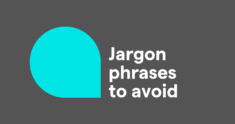
How to Write a Cover Letter [Full Guide & Examples for 2024]

After weeks of heavy job searching, you’re almost there!
You’ve perfected your resume.
You’ve short-listed the coolest jobs you want to apply for.
You’ve even had a friend train you for every single interview question out there.
But then, before you can send in your application and call it a day, you remember that you need to write a cover letter too.
So now, you’re stuck staring at a blank page, wondering where to start...
Don’t panic! We’ve got you covered. Writing a cover letter is a lot simpler than you might think.
In this guide, we’re going to teach you how to write a cover letter that gets you the job you deserve.
We're going to cover:
What Is a Cover Letter?
- How to Write the Perfect Cover Letter, Step by Step
- 15+ Job-Winning Cover Letter Examples
Let’s get started.
A cover letter is a document that you submit as part of your job application, alongside your resume or CV.
The purpose of a cover letter is to introduce you and briefly summarize your professional background. On average, it should be around 250 to 400 words long .
A good cover letter is supposed to impress the hiring manager and convince them you’re worth interviewing as a candidate.
So, how can your cover letter achieve this?
First of all, it should complement your resume, not copy it. Your cover letter is your chance to elaborate on important achievements, skills, or anything else that your resume doesn’t give you the space to cover.
For example, if you have an employment gap on your resume, the cover letter is a great place to explain why it happened and how it helped you grow as a person.
If this is your first time writing a cover letter, writing about yourself might seem complicated. But don’t worry—you don’t need to be super creative or even a good writer .
All you have to do is follow this tried and tested cover letter structure:

- Header. Add all the necessary contact information at the top of your cover letter.
- Formal greeting. Choose an appropriate way to greet your target audience.
- Introduction. Introduce yourself in the opening paragraph and explain your interest in the role.
- Body. Elaborate on why you’re the best candidate for the job and a good match for the company. Focus on “selling” your skills, achievements, and relevant professional experiences.
- Conclusion. Summarize your key points and wrap it up professionally.
Now, let’s take a look at an example of a cover letter that follows our structure perfectly:

New to cover letter writing? Give our cover letter video a watch before diving into the article!
When Should You Write a Cover Letter?
You should always include a cover letter in your job application, even if the hiring manager never reads it. Submitting a cover letter is as important as submitting a resume if you want to look like a serious candidate.
If the employer requests a cover letter as part of the screening process, not sending one is a huge red flag and will probably get your application tossed into the “no” pile immediately.
On the other hand, if the job advertisement doesn’t require a cover letter from the candidates, adding one shows you went the extra mile.
Putting in the effort to write a cover letter can set you apart from other candidates with similar professional experience and skills, and it could even sway the hiring manager to call you for an interview if you do it right.
Need to write a letter to help get you into a good school or volunteer program? Check out our guide to learn how to write a motivation letter !
How to Write the Perfect Cover Letter
Now that you know what a cover letter is, it’s time to learn how to write one!
We’ll go through the process in detail, step by step.
#1. Choose the Right Cover Letter Template
A good cover letter is all about leaving the right first impression.
So, what’s a better way to leave a good impression than a well-formatted, stylish template?

Just choose one of our hand-picked cover letter templates , and you’ll be all set in no time!
As a bonus, our intuitive AI will even give you suggestions on how to improve your cover letter as you write it. You’ll have the perfect cover letter done in minutes!

#2. Put Contact Information in the Header
As with a resume, it’s important to
start your cover letter
with your contact details at the top. These should be in your cover letter’s header, separated neatly from the bulk of your text.

Here, you want to include all the essential contact information , including:
- Full Name. Your first and last name should stand out at the top.
- Job Title. Match the professional title underneath your name to the exact job title of the position you’re applying for. Hiring managers often hire for several roles at once, so giving them this cue about what role you’re after helps things go smoother.
- Email Address. Always use a professional and easy-to-spell email address. Ideally, it should combine your first and last names.
- Phone Number. Add a number where the hiring manager can easily reach you.
- Location. Add your city and state/country, no need for more details.
- Relevant Links (optional). You can add links to websites or social media profiles that are relevant to your field. Examples include a LinkedIn profile , Github, or an online portfolio.
Then it’s time to add the recipient’s contact details, such as:
- Hiring Manager's Name. If you can find the name of the hiring manager, add it.
- Hiring Manager's Title. While there’s no harm in writing “hiring manager,” if they’re the head of the department, we recommend you use that title accordingly.
- Company Name. Make sure to write the name of the company you're applying to.
- Location. The city and state/country are usually enough information here, too.
- Date of Writing (Optional). You can include the date you wrote your cover letter for an extra professional touch.

#3. Address the Hiring Manager
Once you’ve properly listed all the contact information, it’s time to start writing the content of the cover letter.
The first thing you need to do here is to address your cover letter directly to the hiring manager.
In fact, you want to address the hiring manager personally .
Forget the old “Dear Sir or Madam” or the impersonal “To Whom It May Concern.” You want to give your future boss a good impression and show them that you did your research before sending in your application.
No one wants to hire a job seeker who just spams 20+ companies and hopes something sticks with their generic approach
So, how do you find out who’s the hiring manager?
First, check the job ad. The hiring manager’s name might be listed somewhere in it.
If that doesn’t work, check the company’s LinkedIn page. You just need to look up the head of the relevant department you’re applying to, and you’re all set.
For example, if you’re applying for the position of Communication Specialist at Novorésumé. The hiring manager is probably the Head of Communications or the Chief Communications Officer.
Here’s what you should look for on LinkedIn:

And there you go! You have your hiring manager.
But let’s say you’re applying for a position as a server . In that case, you’d be looking for the “restaurant manager” or “food and beverage manager.”
If the results don’t come up with anything, try checking out the “Team” page on the company website; there’s a good chance you’ll at least find the right person there.
Make sure to address them as Mr. or Ms., followed by their last name. If you’re not sure about their gender or marital status, you can just stick to their full name, like so:
- Dear Mr. Kurtuy,
- Dear Andrei Kurtuy,
But what if you still can’t find the hiring manager’s name, no matter where you look?
No worries. You can direct your cover letter to the company, department, or team as a whole, or just skip the hiring manager’s name.
- Dear [Department] Hiring Manager
- Dear Hiring Manager
- Dear [Department] Team
- Dear [Company Name]
Are you applying for a research position? Learn how to write an academic personal statement .
#4. Write an Eye-Catching Introduction
First impressions matter, especially when it comes to your job search.
Hiring managers get hundreds, sometimes even thousands, of applications. Chances are, they’re not going to be reading every single cover letter end-to-end.
So, it’s essential to catch their attention from the very first paragraph.
The biggest problem with most opening paragraphs is that they’re usually extremely generic. Here’s an example:
- My name is Jonathan, and I’d like to work as a Sales Manager at XYZ Inc. I’ve worked as a Sales Manager at MadeUpCompany Inc. for 5+ years, so I believe that I’d be a good fit for the position.
See the issue here? This opening paragraph doesn’t say anything except the fact that you’ve worked the job before.
And do you know who else has similar work experience? All the other applicants you’re competing with.
Instead, you want to start with some of your top achievements to grab the reader’s attention. And to get the point across, the achievements should be as relevant as possible to the position.
Your opening paragraph should also show the hiring manager a bit about why you want this specific job. For example, mention how the job relates to your plans for the future or how it can help you grow professionally. This will show the hiring manager that you’re not just applying left and right—you’re actually enthusiastic about getting this particular role.
Now, let’s make our previous example shine:
Dear Mr. Smith,
My name’s Michael, and I’d like to help XYZ Inc. hit and exceed its sales goals as a Sales Manager. I’ve worked as a Sales Representative with Company X, another fin-tech company , for 3+ years, where I generated an average of $30,000+ in sales per month and beat the KPIs by around 40%. I believe that my previous industry experience, passion for finance , and excellence in sales make me the right candidate for the job.
The second candidate starts with what they can do for the company in the future and immediately lists an impressive and relevant achievement. Since they’re experienced in the same industry and interested in finance, the hiring manager can see they’re not just a random applicant.
From this introduction, it’s safe to say that the hiring manager would read the rest of this candidate’s cover letter.
#5. Use the Cover Letter Body for Details
The next part of your cover letter is where you can go into detail about what sets you apart as a qualified candidate for the job.
The main thing you need to remember here is that you shouldn’t make it all about yourself . Your cover letter is supposed to show the hiring manager how you relate to the job and the company you’re applying to.
No matter how cool you make yourself sound in your cover letter, if you don’t tailor it to match what the hiring manager is looking for, you’re not getting an interview.
To get this right, use the job ad as a reference when writing your cover letter. Make sure to highlight skills and achievements that match the job requirements, and you’re good to go.
Since this part of your cover letter is by far the longest, you should split it into at least two paragraphs.
Here’s what each paragraph should cover:
Explain Why You’re the Perfect Candidate for the Role
Before you can show the hiring manager that you’re exactly what they’ve been looking for, you need to know what it is they’re looking for.
Start by doing a bit of research. Learn what the most important skills and responsibilities of the role are according to the job ad, and focus on any relevant experience you have that matches them.
For example, if you’re applying for the position of a Facebook Advertiser. The top requirements on the job ad are:
- Experience managing a Facebook ad budget of $10,000+ / month
- Some skills in advertising on other platforms (Google Search + Twitter)
- Excellent copywriting skills
So, in the body of your cover letter, you need to show how you meet these requirements. Here’s an example of what that can look like:
In my previous role as a Facebook Marketing Expert at XYZ Inc. I handled customer acquisition through ads, managing a monthly Facebook ad budget of $40,000+ . As the sole digital marketer at the company, I managed the ad creation and management process end-to-end. I created the ad copy and images, picked the targeting, ran optimization trials, and so on.
Other than Facebook advertising, I’ve also delved into other online PPC channels, including:
- Google Search
Our example addresses all the necessary requirements and shows off the candidate’s relevant skills.
Are you a student applying for your first internship? Learn how to write an internship cover letter with our dedicated guide.
Explain Why You’re a Good Fit for the Company
As skilled and experienced as you may be, that’s not all the hiring manager is looking for.
They also want someone who’s a good fit for their company and who actually wants to work there.
Employees who don’t fit in with the company culture are likely to quit sooner or later. This ends up costing the company a ton of money, up to 50% of the employee’s annual salary , so hiring managers vet candidates very carefully to avoid this scenario.
So, you have to convince the hiring manager that you’re passionate about working with them.
Start by doing some research about the company. You want to know things like:
- What’s the company’s business model?
- What’s the company’s product or service? Have you used it?
- What’s the company’s culture like?
Chances are, you’ll find all the information you need either on the company website or on job-search websites like Jobscan or Glassdoor.
Then, pick your favorite thing about the company and talk about it in your cover letter.
But don’t just describe the company in its own words just to flatter them. Be super specific—the hiring manager can see through any fluff.
For example, if you’re passionate about their product and you like the company’s culture of innovation and independent work model, you can write something like:
I’ve personally used the XYZ Smartphone, and I believe that it’s the most innovative tech I’ve used in years. The features, such as Made-Up-Feature #1 and Made-Up-Feature #2, were real game changers for the device.
I really admire how Company XYZ strives for excellence in all its product lines, creating market-leading tech. As someone who thrives in a self-driven environment, I truly believe that I’ll be a great match for your Product Design team.
So, make sure to do your fair share of research and come up with good reasons why you're applying to that specific company.
Is the company you want to work for not hiring at the moment? Check out our guide to writing a letter of interest .
#6. Wrap It Up and Sign It
Finally, it’s time to conclude your cover letter.
In the final paragraph, you want to:
- Wrap up any points you couldn't make in the previous paragraphs. Do you have anything left to say? If there’s any other information that could help the hiring manager make their decision, mention it here. If not, just recap your key selling points so far, such as key skills and expertise.
- Express gratitude. Politely thanking the hiring manager for their time is always a good idea.
- Finish the cover letter with a call to action. The very last sentence in your cover letter should be a call to action. This means you should ask the hiring manager to do something, like call you and discuss your application or arrange an interview.
- Remember to sign your cover letter. Just add a formal closing line and sign your name at the bottom.
Here’s an example of how to end your cover letter :
I hope to help Company X make the most of their Facebook marketing initiatives. I'd love to further discuss how my previous success at XYZ Inc. can help you achieve your Facebook marketing goals. Please don’t hesitate to reach out to me at the provided email address or phone number so that we may arrange an interview.
Thank you for your consideration,
Alice Richards
Feel free to use one of these other popular closing lines for your cover letter:
- Best Regards,
- Kind Regards,
Cover Letter Writing Checklist
Once you’re done with your cover letter, it’s time to check if it meets all industry requirements.
Give our handy cover letter writing checklist a look to make sure:
Does your cover letter heading include all essential information?
- Professional Email
- Phone Number
- Relevant Links
Do you address the right person?
- The hiring manager in the company
- Your future direct supervisor
- The company/department in general
Does your introductory paragraph grab the reader's attention?
- Did you mention some of your top achievements?
- Did you use numbers and facts to back up your experience?
- Did you convey enthusiasm for the specific role?
Do you show that you’re the right candidate for the job?
- Did you identify the core requirements for the role?
- Did you show how your experiences helped you fit the requirements perfectly?
Do you convince the hiring manager that you’re passionate about the company you’re applying to?
- Did you identify the top 3 things that you like about the company?
- Did you avoid generic reasons for explaining your interest in the company?
Did you conclude your cover letter properly?
- Did you recap your key selling points in the conclusion?
- Did you end your cover letter with a call to action?
- Did you use the right formal closing line and sign your name?
15 Cover Letter Tips
Now you’re all set to write your cover letter!
Before you start typing, here are some cover letter tips to help take your cover letter to the next level:
- Customize Your Cover Letter for Each Job. Make sure your cover letter is tailored to the job you're applying for. This shows you're not just sending generic applications left and right, and it tells the hiring manager you’re the right person for the job.
- Showcase Your Skills. Talk about how your skills meet the company’s needs. And while your hard skills should be front and center, you shouldn’t underestimate your soft skills in your cover letter either.
- Avoid Fluff. Don’t make any generic statements you can’t back up. The hiring manager can tell when you’re just throwing words around, and it doesn’t make your cover letter look good.
- Use Specific Examples. Instead of saying you're great at something, give an actual example to back up your claim. Any data you can provide makes you sound more credible, so quantify your achievements. For example, give numbers such as percentages related to your performance and the timeframe it took to accomplish certain achievements.
- Research the Company. Always take time to learn about the company you're applying to. Make sure to mention something about them in your cover letter to show the hiring manager that you're interested.
- Follow the Application Instructions. If the job posting asks for something specific in your cover letter or requires a certain format, make sure you include it. Not following instructions can come off as unattentive or signal to the hiring manager that you’re not taking the job seriously.
- Use the Right Template and Format. Choose the right cover letter format and adapt your cover letter’s look to the industry you’re applying for. For example, if you’re aiming for a job in Law or Finance, you should go for a cleaner, more professional look. But if you’re applying for a field that values innovation, like IT or Design, you have more room for creativity.
- Express Your Enthusiasm. Let the hiring manager know why you're excited about the job. Your passion for the specific role or the field in general can be a big selling point, and show them that you’re genuinely interested, not just applying left and right.
- Address Any Gaps. If there are any employment gaps in your resume , your cover letter is a great place to mention why. Your resume doesn’t give you enough space to elaborate on an employment gap, so addressing it here can set hiring managers at ease—life happens, and employers understand.
- Avoid Quirky Emails. Your email address should be presentable. It’s hard for a hiring manager to take you seriously if your email address is “[email protected].” Just use a [email protected] format.
- Check Your Contact Information. Typos in your email address or phone number can mean a missed opportunity. Double-check these before sending your application.
- Mention if You Want to Relocate. If you’re looking for a job that lets you move somewhere else, specify this in your cover letter.
- Keep It Brief. You want to keep your cover letter short and sweet. Hiring managers don’t have time to read a novel, so if you go over one page, they simply won’t read it at all.
- Use a Professional Tone. Even though a conversational tone isn’t a bad thing, remember that it's still a formal document. Show professionalism in your cover letter by keeping slang, jargon, and emojis out of it.
- Proofread Carefully. Typos and grammar mistakes are a huge deal-breaker. Use a tool like Grammarly or QuillBot to double-check your spelling and grammar, or even get a friend to check it for you.
15+ Cover Letter Examples
Need some inspiration? Check out some perfect cover letter examples for different experience levels and various professions.
5+ Cover Letter Examples by Experience
#1. college student cover letter example.

Check out our full guide to writing a college student cover letter here.
#2. Middle Management Cover Letter Example

Check out our full guide to writing a project manager cover letter here.
#3. Team Leader Cover Letter Example

Check out our full guide to writing a team leader cover letter here.
#4. Career Change Cover Letter Example

Check out our full guide to a career change resume and cover letter here.
#5. Management Cover Letter Example

Check out our full guide to writing a management cover letter here.
#6. Senior Executive Cover Letter Example

Check out our full guide to writing an executive resume here.
9+ Cover Letter Examples by Profession
#1. it cover letter example.

Check out our full guide to writing an IT cover letter here.
#2. Consultant Cover Letter Example

Check out our full guide to writing a consultant cover letter here.
#3. Human Resources Cover Letter

Check out our full guide to writing a human resources cover letter here.
#4. Business Cover Letter Example

Check out our full guide to writing a business cover letter here.
#5. Sales Cover Letter Example

Check out our full guide to writing a sales cover letter here.
#6. Social Worker Cover Letter

Check out our full guide to writing a social worker cover letter here.
#7. Lawyer Cover Letter

Check out our full guide to writing a lawyer cover letter here.
#8. Administrative Assistant Cover Letter

Check out our full guide to writing an administrative assistant cover letter here.
#9. Engineering Cover Letter Example

Check out our full guide to writing an engineer cover letter here.
#10. Receptionist Cover Letter Example

Check out our full guide to writing a receptionist cover letter here.
Need more inspiration? Check out these cover letter examples to learn what makes them stand out.
Plug & Play Cover Letter Template
Not sure how to start your cover letter? Don’t worry!
Just copy and paste our free cover letter template into the cover letter builder, and swap out the blanks for your details.
[Your Full Name]
[Your Profession]
[Your Phone Number]
[Your Email Address]
[Your Location]
[Your LinkedIn Profile URL (optional)]
[Your Personal Website URL (optional)]
[Recipient's Name, e.g., Jane Doe],
[Recipient's Position, e.g., Hiring Manager]
[Company Name, e.g., ABC Corporation]
[Company Address]
[City, State/Country]
Dear [Recipient's Name],
As a seasoned [Your Profession] with [Number of Years of Experience] years of industry experience, I am eager to express my interest in the [Job Title] position at [Company Name]. With my experience in [Your Industry/Sector] and the successes I've achieved throughout my education and career, I believe I can bring unique value and creativity to your team.
In my current role as [Your Current Job Title], I've taken the lead on more than [Number of Projects/Assignments] projects, some valued up to $[Highest Project Value]. I pride myself on consistently exceeding client expectations and have successfully [Mention a Key Achievement] in just a [Amount of Time] through [Skill] and [Skill].
I've collaborated with various professionals, such as [List Roles], ensuring that all [projects/tasks] meet [relevant standards or objectives]. This hands-on experience, coupled with my dedication to understanding each [client's/customer's] vision, has equipped me to navigate and deliver on complex projects.
My key strengths include:
- Improving [Achievement] by [%] over [Amount of Time] which resulted in [Quantified Result].
- Optimizing [Work Process/Responsibility] which saved [Previous Employer] [Amount of Time/Budget/Other Metric] over [Weeks/Months/Years]
- Spearheading team of [Number of People] to [Task] and achieving [Quantified Result].
Alongside this letter, I've attached my resume. My educational background, a [Your Degree] with a concentration in [Your Specialization], complements the practical skills that I'm particularly eager to share with [Company Name].
I'm excited about the possibility of contributing to [Something Notable About the Company or Its Mission]. I'd be grateful for the chance to delve deeper into how my expertise aligns with your needs.
Thank you for considering my application, and I look forward to hearing from you soon.
The Heart of Your Job Search - Creating a Killer Resume
Your cover letter is only as good as your resume. If either one is weak, your entire application falls through.
After all, your cover letter is meant to complement your resume. Imagine going through all this effort to leave an amazing first impression in your cover letter, only for the hiring manager to never read it because your resume was mediocre.
But don’t worry; we’ve got you covered here, too.
Check out our dedicated guide on how to make a resume and learn everything you need to know to land your dream job!
Just pick one of our resume templates and start writing your own job-winning resume.

Key Takeaways
Now that we’ve walked you through all the steps of writing a cover letter, let’s summarize everything we’ve learned:
- A cover letter is a 250 - 400 word document that’s meant to convince the hiring manager that you’re the best candidate for the job.
- Your job application should always include a cover letter alongside your resume.
- To grab the hiring manager’s attention, write a strong opening paragraph. Mention who you are, why you’re applying, and a standout achievement to pique their interest.
- Your cover letter should focus on why you’re the perfect candidate for the job and why you’re passionate about working in this specific company.
- Use the body of your cover letter to provide details on your skills, achievements, and qualifications, as well as make sure to convey your enthusiasm throughout your whole cover letter.
- Recap your key selling points towards the end of your cover letter, and end it with a formal closing line and your full name signed underneath.
At Novorésumé, we’re committed to helping you get the job you deserve every step of the way!
Follow our career blog for more valuable advice, or check out some of our top guides, such as:
- How to Make a Resume in 2024 | Beginner's Guide
- How to Write a CV (Curriculum Vitae) in 2024 [31+ Examples]
- 35+ Job Interview Questions and Answers [Full List]

To provide a safer experience, the best content and great communication, we use cookies. Learn how we use them for non-authenticated users.
Explore Jobs
- Jobs Near Me
- Remote Jobs
- Full Time Jobs
- Part Time Jobs
- Entry Level Jobs
- Work From Home Jobs
Find Specific Jobs
- $15 Per Hour Jobs
- $20 Per Hour Jobs
- Hiring Immediately Jobs
- High School Jobs
- H1b Visa Jobs
Explore Careers
- Business And Financial
- Architecture And Engineering
- Computer And Mathematical
Explore Professions
- What They Do
- Certifications
- Demographics
Best Companies
- Health Care
- Fortune 500
Explore Companies
- CEO And Executies
- Resume Builder
- Career Advice
- Explore Majors
- Questions And Answers
- Interview Questions
How To Write A Job Application Letter (With Examples)
- Best Business Salutations
- Letter of Introduction
- Close a Business Letter
- Job Application Letter
- Business Letter Layout
- To Whom It May Concern
- Letter Of Interest
- Letter Envelope
- Experience Letter
- How To Write A Letter
Find a Job You Really Want In
While applying to jobs, you might be asked to provide a job application letter (sometimes referred to as a cover letter) along with your resume. A resume outlines your professional skills and experience, and a job application letter explains why you are an ideal candidate for the position you’re applying to.
You can think of this as a strictly formatted professional letter that gives hiring managers a sense of your individual qualities prior to a job interview.
This article outlines the essential details and formatting for a job application letter. You’ll learn how to write a concise and engaging letter that will increase your chances of being selected for an interview.
Key Takeaways:
A job application letter can also be known as a cover letter. It is a way to introduce how your skills and experience are a good match for the job.
A job application letter should have your contact information, employer contact information, and a salutation,
A job application application letter should have an introductory paragraph, middle paragraphs that explain your qualifications, and a closing paragraph.
Use specific experiences with quantifiable results to show how your skills were successfully put into action.
Make sure to do your research and edit your letter before submitting.

Tips for writing a job application letter
Job application letter format, what’s the difference between a cover letter and a job application letter, dos and don’ts for writing a job application letter.
- Sign Up For More Advice and Jobs
If you’ve ever asked for advice on the job application process, you’ve likely heard the phrase “sell yourself” a million times over. This means that you should highlight your skills and achievements in a way that will pique a hiring manager ’s interest and make them pause over your application.
You might feel overwhelmed in the grand scheme of online applications, application/ cover letters , letters of intent , and interviews. It’s a lot to balance, especially if you have no experience with any of the things listed.
Remember to take everything one step at a time and review some helpful tips for writing a polished and engaging job application letter:
Tailor the application letter to each job. Your letter should address key points in the job description from the listing, as well as how you can apply your knowledge and experience to the position. You want to emphasize why you are the best candidate for this specific job.
Don’t copy information straight from your resume. Your resume is meant to act as a formal record of your professional experience, education, and accomplishments. The job application letter is where you highlight a few particular details from your resume, and use them to demonstrate how your experience can apply to the job.
Follow the business letter format. These letters have very strict formatting rules, to ensure that they appear as professional to hiring managers. A poorly formatted letter could prevent employers from taking your application seriously.
Proofread. Hiring managers will definitely overlook letters riddled with proofreading mistakes. Read your letter several times over to fix any grammar, punctuation, or spelling errors. You could ask someone else to look over it afterwards or run it through any number of online grammar check programs.
Decide on printing and mailing your letter or sending it in an email. An application letter sent through email requires a subject line that details your purpose for writing— consider “[job title], [your name].” The placement of your contact information is also different depending on the medium . In a hard copy, this goes at the top of your letter, as a header. In an email, it goes below your signature.
The following formatting information can be used as a guideline while drafting your own job application letter, with an example for both a printed/mailed letter and a letter sent through email.
Your contact information
Name Address City, State Zip Code Phone Number Email Address
Employer contact information
First paragraph
Middle paragraphs
This section should be about one to three paragraphs, discussing your various qualifications for the job. This is where you really emphasize what you could bring to the company and how you might fit into the work environment. It might be necessary to do some additional research about the company, to lend more specificity to your letter.
Final paragraph
Ending a cover letter might be a challenge, as you try to wrap up all the details about why you’re the most well-qualified employee on the planet. Let that confidence carry over into your concluding paragraph.
Sincerely/Best,
Job application letter example – printed and mailed
Robin Gomez 37 Southwest Avenue Gainesville, FL 12345 365-123-4567 [email protected] October 20, 2020 Ms. Martha Waters Hiring Manager Blue Swamp Publishing 27 Archer Street Gainesville, FL 67890 Dear Ms. Waters, My resume is attached in response to your advertisement for an editorial assistant . The job description aligns with my interest in editing short fiction, and I believe my experience and skills match what you’re looking for. This past year, I interned with the Editing, Design and Production department at Gator University Press. Over the course of two semesters, I interacted with academic texts at various stages before publication. I’m comfortable proofreading and copyediting manuscripts, as well as adding typesetting codes in Microsoft Word. I have also previously worked on the staff of Writers Student Literary Magazine in Jacksonville, FL , as the Fiction and Website Editor, as well as the head of the Proofreading Team. I played a significant role in the publication of six issues of the magazine, across a two year period (including print and online editions). My qualifications beyond this include experience in team-oriented settings and proficiency in creative and academic writing. I would love the opportunity to speak with you about how I can further contribute to Blue Swamp Publishing! Please feel free to contact me on my cell at 365-123-4567 if you have questions or to set up an interview. Sincerely, Robin Gomez
Job application letter example – emailed
Subject Line: Victoria Caruso – Public Relations Assistant Dear Ms. Janet Wang, I was excited when my colleague Rachel Smith told me that you were looking for a public relations assistant with a background in graphic design. She suggested that I reach out to you about the position, since I believe that my experience aligns well with what you are seeking at Trademark Agency. I worked alongside Rachel as a brand ambassador at a small graphic design company for three years, where I excelled in project management, strategy development, and client communication. This past spring, I played a significant role in designing the website for an up-and-coming multicultural women’s organization and publicizing their first few public events. Along with my experience and personal qualities, I prioritize: Expanding company recognition and designing unique brand details Managing media, press, and public relations issues for companies Developing company communication strategies Please see my attached resume for additional details about my career achievements. I hope to learn more about Trademark Agency’s goals for the coming year. You can contact me on my cell at 319-333-3333 or via email at [email protected]. Sincerely, Victoria Caruso 15th Avenue N Iowa City, Iowa 52240 319-333-3333 [email protected]
A cover letter normally is attached with a resume for a specific job opening, whereas a job application letter can be submitted independently. As already stated, a job application letter can also be known as a cover letter. Format wise, there are a lot of similarities.
However, a job application letter can also be more detailed than a cover a letter. Usually a cover letter acts a quick introduction to a resume when a candidate applies for a specific job opening.
Meanwhile, you can submit a job application letter to a company even if there are no job openings. In this case, you would provide more detail about yourself and your qualifications. Due to this, job application letters tend to be a little longer than the average cover letter.
Now that we’ve gone through the basic formatting for a job application letter and a few examples of what one might look like, how can we condense all that information into digestible pieces?
Refer to these lists of “dos” and “don’ts” to help you through your drafting process:
Explain what you can bring to the company. Consider: how is your experience relevant to what the hiring manager is looking for?
Discuss your skills. Pick out a few skills listed in your resume and describe how you have utilized them in the workplace.
Give specific examples to support your experience. Is there a major project you worked on at your last job ? Did you accomplish something significant in your previous position? Including examples of these things in your letter will add new, specific content to your application and make you more interesting.
Edit your letter thoroughly. Read your letter a couple times, pass it off to someone to look over, run it through an online grammar check. Make sure it’s free of any errors.
Don’t focus on what the job can do for you. While it might seem nice to write that a job is your dream job or that you’ve always wanted to work with a company, it can read as vague flattery. Remember, this letter is about your qualifications.
Don’t list your current or previous job description. Your education and work experience certainly have value, but don’t just list your degrees and places you’ve worked at. Explained what you learned from those experiences and how they’ve made you a strong employee.
Don’t paste directly from your resume. A job application letter is meant to add to your value as a candidate, not just reiterate the same information repeatedly. Use your resume as a guide , but expand on especially relevant details.
Don’t submit an unedited letter. Before an employer ever meets you, they see your application and your job application letter. You don’t want grammar errors and misspelled words to make a bad first impression, so make sure to edit your draft multiple times.
Armed with these tips, guidelines, and examples, you’ll be able to draft your job application letter more confidently and send them off to potential employers knowing that you’re one step closer to employment.
How useful was this post?
Click on a star to rate it!
Average rating / 5. Vote count:
No votes so far! Be the first to rate this post.

Chris Kolmar is a co-founder of Zippia and the editor-in-chief of the Zippia career advice blog. He has hired over 50 people in his career, been hired five times, and wants to help you land your next job. His research has been featured on the New York Times, Thrillist, VOX, The Atlantic, and a host of local news. More recently, he's been quoted on USA Today, BusinessInsider, and CNBC.
Recent Job Searches
- Registered Nurse Jobs Resume Location
- Truck Driver Jobs Resume Location
- Call Center Representative Jobs Resume Location
- Customer Service Representative Jobs Resume
- Delivery Driver Jobs Resume Location
- Warehouse Worker Jobs Resume Location
- Account Executive Jobs Resume Location
- Sales Associate Jobs Resume Location
- Licensed Practical Nurse Jobs Resume Location
- Company Driver Jobs Resume
Related posts
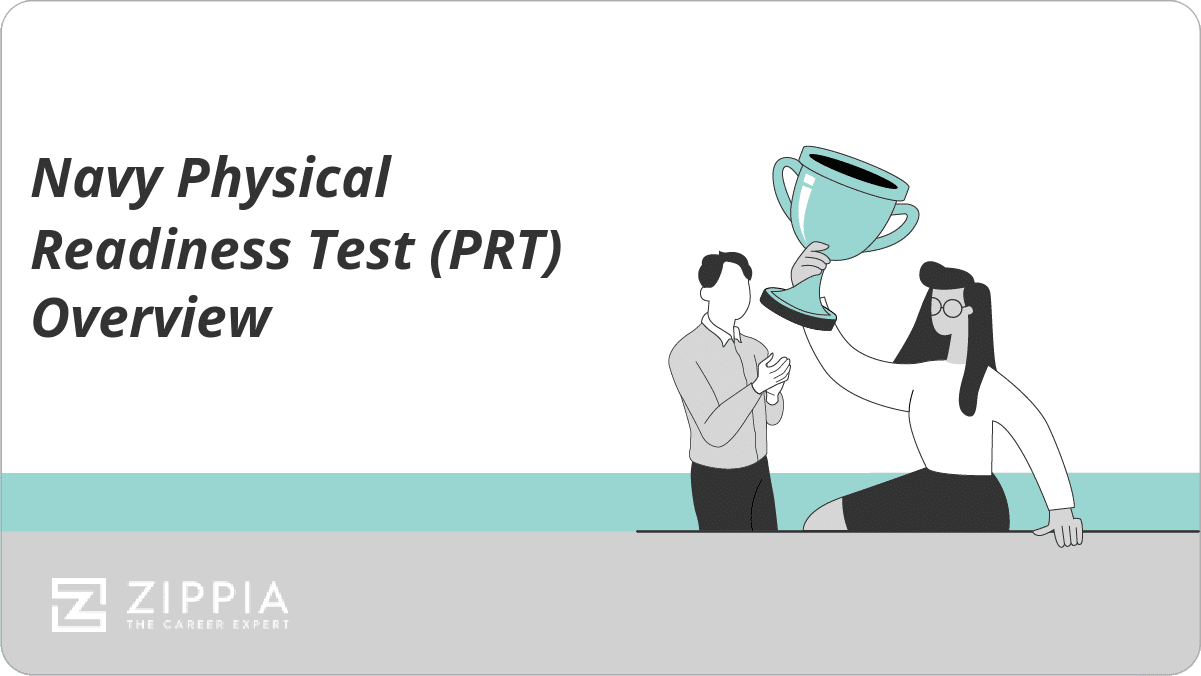
Navy Physical Readiness Test (PRT) Overview

What To Bring To A Job Fair (With Examples)

How To Create A Job Search Spreadsheet (With Examples)
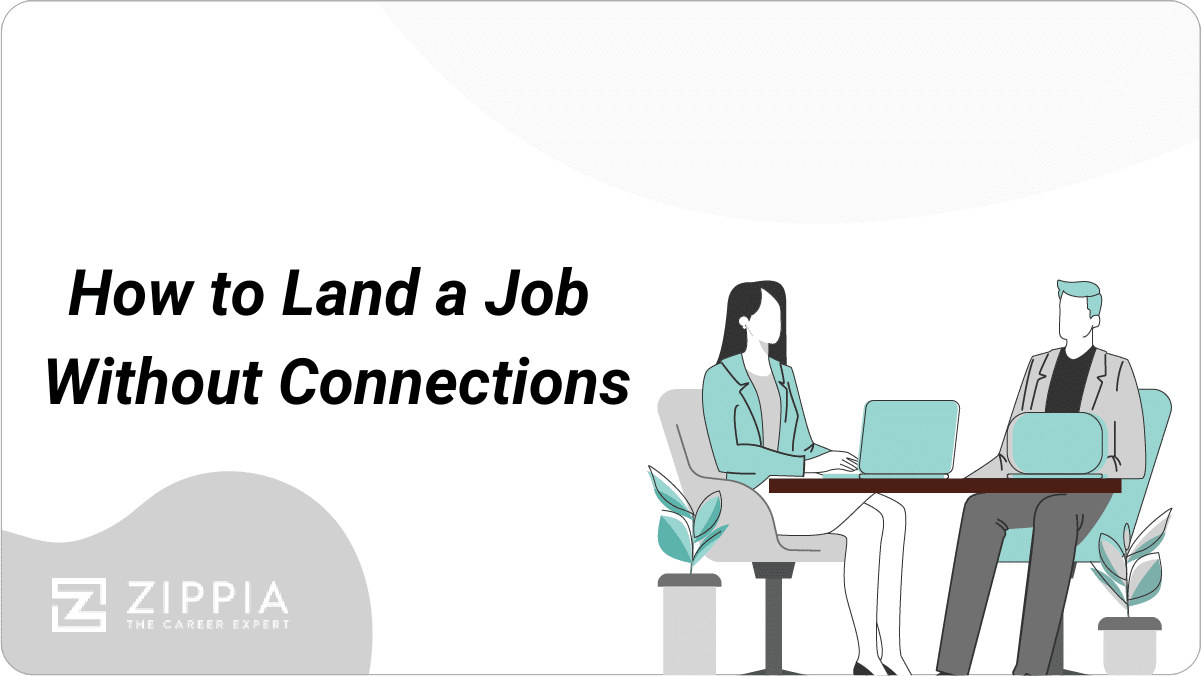
How To Land A Job Without Connections
- Career Advice >
- Apply For Jobs >
- Online Degree Explore Bachelor’s & Master’s degrees
- MasterTrack™ Earn credit towards a Master’s degree
- University Certificates Advance your career with graduate-level learning
- Top Courses
- Join for Free
How to Write a Cover Letter for a Job Application
Including a cover letter with you job application takes a little extra time, but it can mean the difference between getting an interview and your CV being discarded.
![difference of a cover letter and job application letter [Featured image] Applicant writes a cover letter on a blue clipboard](https://d3njjcbhbojbot.cloudfront.net/api/utilities/v1/imageproxy/https://images.ctfassets.net/wp1lcwdav1p1/6hXTBWimkTK7cwzp8n2Bia/4825f1492b3712171214e072bcc6d247/GettyImages-1159565335__2_.jpg?w=1500&h=680&q=60&fit=fill&f=faces&fm=jpg&fl=progressive&auto=format%2Ccompress&dpr=1&w=1000)
Learn how to write an effective cover letter as part of your job application to maximise your chances of getting an interview.
When applying for a job, more often than not, you will need to include a cover letter. Consider your cover letter your sales page, giving an introduction to yourself and an invitation to the recruiter to read your CV or application. It’s not always clear whether you need a cover letter or not when studying a job advert, so if you’re unsure, always include one. A good cover letter could be the difference between the hiring manager reading your CV, or discarding your application and moving on.
Get your facts together
Writing a cover letter for the first time can seem a daunting prospect. With so much that could be included, it’s hard to know where to start. The best place is by getting your facts together and deciding what you want to include.
Think of all your accomplishments to date that are relevant to the role and make a list. Try not to use anything that comes directly from your CV. Your cover letter is the place to elaborate on the points in your CV to provide more detail and to really highlight what you can do, rather than repeating points.
Also do some research on the company. Find out what its values are, its mission, and any defining features. This will help you tailor your experience and skills to the company culture and give you some background to explain why you are a good fit.
Address the criteria
It’s important that you don’t include anything and everything. Less is more with a job application cover letter. You will be scored on how well you meet the selection criteria, so use that as a guide for what to include. Link everything you write back to the criteria, and try to find relevant examples where possible.
If you don’t have an industry related example to hit a criterium, use something else, but make it very clear what it is demonstrating. There are many ways to demonstrate soft skills. For example, learning a language can demonstrate your communication skills, and being part of a sports team can show that you know how to work well with others.
When you know what you want to include, put a plan in place for the structure of the letter, and writing it will be much easier.
Start with a strong opening
If you want a recruiter to read the entirety of your cover letter and consequently move on to your CV, the opening is what you need to focus on. You want to draw the reader in and impress them enough to keep their attention. This means addressing the letter properly and giving a clear reason for writing.
In the case of a job application cover letter, you will need to state what you are applying for and what makes you the ideal candidate. This will be covered further in the bulk of the letter, but the first paragraph can be a summary of your experience, skills, and accomplishments, linked clearly to why this makes you the ideal candidate and giving a taste of what’s to come in the rest of the letter.
Make connections
Your research on the company will be beneficial in helping you to tailor the cover letter for a job application. Generic cover letters don’t do well. Job application cover letters that have been tailored to the role perform best. Aside from ensuring you evidence how you meet the job criteria, you can also make it clear that you know the company you’re applying to and value what it does.
Mention something in your cover letter that particularly draws you to the position or company and aligns with your values, experience, or way of working to show that you have done your research and have picked this company specifically as a result.
Be confident about your achievements
The body of your cover letter is where you highlight your relevant achievements in relation to the role you’re applying for. Don’t be vague here. Clear, evidence-based examples do best when communicating your value, so be confident in citing what you’ve accomplished throughout your career and how that relates to what you can do in the role in question.
Use numbers
To back up your accomplishments, use numbers to really highlight your results. Rather than stating you increased a company’s ROI, how much did you increase it by? If you have a percentage value, this adds clout to your examples. Similarly, use figures when talking about how many people you manage or how many delegates you got through the door at an event you organised. Adding a measurable gives your achievements more weight.
Use keywords
To ensure that you're really tailoring your job application cover letter, it’s helpful to use the job description to pick out keywords. Using the exact wording used in the advert, job description, and person specification, will mean you have the best chance of passing ATS screening systems, which scan your application for keywords to determine whether you are a good match.
Be positive and enthusiastic
Give your cover letter for a job a positive, enthusiastic tone. Use future tense to show how you will use your skills and experience to benefit the company you’re applying to and show how keen you are to take on a new role and new challenges.
If you are lacking experience in some areas, don’t highlight it. Always find a way to compensate for it, without implying it is a negative factor. For example, if you don’t have experience in project management, but you have a qualification in Scrum, write about your qualification and all the benefits that brings, without pointing out your lack of experience.
Call to action
Your cover letter should always end with a clear call to action. In your last paragraph, sum up your skills and experience and make it apparent that you would welcome discussion around your application and the role. You can be bold and propose your availability or simply tell the reader that you will look forward to hearing from them regarding an interview.
Cover letter structure
Taking on board all of the advice above, you can consider the following structure for your cover letter for a job application. This can of course be varied to suit your needs but is a great outline. Look to write no more than a page, unless you are writing a cover letter that is a part of the application process and you need to address all of the essential criteria. In this case, take the space you need.
Dear …………………………………
I’m writing in application of the role of XXXXXXXXXXXXXXX which I saw advertised on XXXXXXXXXXXXXXX. - Approx 10-20 words.
Opening paragraph: Cover why you are writing (what you are applying for), why you are interested in this company and role, and why you are a great fit (giving an overview of your relevant skills and experience). - Approx70-100 words
Middle paragraphs: Depending on what you need to cover, this could vary between one and three paragraphs. This is essentially the most important part of the cover letter, where you detail your skills, experience and accomplishments, in evidence of the selection criteria. Pick out the most important requirements from the person specification and evidence your ability to meet them. - 100 - 250 words in total.
Closing paragraph: Include a brief summary of why you are the ideal candidate for the role and include a strong call to action. - Approx 25- 50 words
Get started
Use this guide to write a cover letter for a job that can help you get you noticed and land an interview. For advice on how to write cover letters for specific roles, you can take a look at these articles. If you are looking for further support, you can take a look at cover letter courses on Coursera as a starting point.
Keep reading
Coursera staff.
Editorial Team
Coursera’s editorial team is comprised of highly experienced professional editors, writers, and fact...
This content has been made available for informational purposes only. Learners are advised to conduct additional research to ensure that courses and other credentials pursued meet their personal, professional, and financial goals.

What is the difference between application letter and cover letter? FREE TEMPLATE
General | 11 sep 2023.
In the competitive job market of today, job seekers are constantly on the lookout for ways to stand out and make a positive impression on prospective employers. Two essential tools in the job hunting arsenal are the application letter and the cover letter. While these terms are often used interchangeably, they serve distinct purposes in the hiring process. In this comprehensive guide, we will explore the key differences between application letters and cover letters, and provide step-by-step instructions on how to create both effectively.
What is an Application Letter?
An application letter, also known as a job application letter or a letter of application, is a formal document submitted by a job seeker to express their interest in a specific job vacancy. The primary purpose of an application letter is to introduce the applicant and their qualifications to the potential employer. Unlike a resume or CV, which provides a comprehensive overview of one's professional history, an application letter is tailored to a particular job opening.
Also read How to Create a Comprehensive Resume
How to Create an Application Letter
1. research the job opening.
Before you begin crafting your application letter, it's crucial to thoroughly research the job opening. This includes understanding the job requirements, responsibilities, and the company's culture. The more you know about the position, the better you can align your qualifications and skills with the employer's needs.
2. Format and Structure
An application letter should follow a standard business letter format. Here's a basic structure to follow:
Heading: Include your contact information (name, address, phone number, and email) at the top, followed by the date.
Recipient's Information: Below the date, include the recipient's name, title, company name, and address. If you can't find this information in the job posting, address the letter to the hiring manager.
Salutation: Start your letter with a professional salutation, such as "Dear Mr. Smith" or "Dear Hiring Manager."
Introduction: Begin with a strong opening paragraph that mentions the specific job you're applying for and how you learned about it. Express your enthusiasm for the position.
Body Paragraph(s): Use one or more paragraphs to highlight your qualifications, skills, and relevant experiences. Be specific and provide examples of how your background aligns with the job requirements.
Closing Paragraph: Summarize your interest in the position and express your desire for an interview. Mention that you have attached your resume for reference.
Closing : Use a formal closing such as "Sincerely" or "Yours faithfully," followed by your signature and typed name.
3. Tailor Your Letter
Each application letter should be customized for the specific job you're applying for. Highlight the qualifications and experiences that make you an ideal candidate for that particular position. Avoid using a generic, one-size-fits-all letter.
4. Showcase Your Skills
Use the application letter to showcase your skills and experiences that are most relevant to the job. Highlight achievements, projects, or experiences that demonstrate your capability to excel in the role.
Also read 7 Interview Tips to Impress Hiring Manager
5. Proofread and Edit
Before sending your application letter, carefully proofread it for grammar, spelling, and formatting errors. A well-written, error-free letter demonstrates professionalism and attention to detail.
6. Enclose Required Documents
If the job posting specifies additional documents, such as transcripts, certifications, or writing samples, make sure to include them along with your application letter.
When to Use an Application Letter
Application letters are typically used when:
A job vacancy is advertised.
The employer specifically requests an application letter.
You want to provide a more personalized introduction to your resume.
Effective Application Letter Example:
[Your Name]
[Your Address]
[City, State ZIP Code]
[Your Email Address]
[Your Phone Number]
[Today's Date]
[Recipient's Name]
[Recipient's Title]
[Company Name]
[Company Address]
Dear [Recipient's Name],
I am writing to apply for the [Position Name] at [Company Name], as advertised on [Where You Found the Job Posting]. With my strong background in [Relevant Skill/Experience], I am excited about the opportunity to contribute my expertise to your team.
In my current role at [Current Company], I have consistently demonstrated my proficiency in [Relevant Skill]. For instance, [Provide an Example of an Achievement or Project Relevant to the Position]. These experiences have honed my abilities and prepared me for the challenges and responsibilities of the [Position Name] role at [Company Name].
What sets [Company Name] apart for me is its reputation for [Company Attribute or Project]. I am deeply impressed by the impact your organization has made in [Industry or Field], and I am eager to be part of such an innovative and forward-thinking team.
Please find my resume attached, which offers a more comprehensive overview of my qualifications. I am enthusiastic about the opportunity to discuss how my skills can contribute to the continued success of [Company Name].
I can be reached at [Your Email Address] or [Your Phone Number]. Thank you for considering my application. I look forward to the possibility of becoming a part of the [Company Name] family and working toward achieving its goals.
What is a Cover Letter?
A cover letter, sometimes referred to as a covering letter, is a document that accompanies your resume when applying for a job. Unlike an application letter, which is typically focused on a specific job vacancy, a cover letter is more general and can be used for various job applications. The primary purpose of a cover letter is to introduce yourself, highlight your qualifications, and explain why you are an excellent fit for the company as a whole.
How to Create a Cover Letter
1. research the company.
Before you start writing your cover letter, research the company you're applying to. Understand its values, mission, culture, and recent achievements. This knowledge will help you tailor your cover letter to align with the company's goals and values.
A well-structured cover letter should include the following elements:
Heading : Similar to an application letter, include your contact information and the date at the top.
Recipient's Information : Address the letter to the hiring manager or the appropriate person if their name is mentioned in the job posting. If not, use a generic salutation like "Dear Hiring Manager."
Introduction : Begin with a strong opening that mentions the position you're interested in and how you found out about it. Express your enthusiasm for the company and explain why you're a good fit.
Body Paragraphs : Use one or more paragraphs to showcase your qualifications, skills, and experiences. Emphasize your contributions and achievements in previous roles. Highlight how your skills align with the company's needs.
Closing Paragraph: Summarize your interest in the company and reiterate your enthusiasm for the position. Express your desire for an interview to further discuss your qualifications.
Closing : Use a professional closing, such as "Sincerely" or "Best regards," followed by your signature and typed name.
3. Personalize Your Cover Letter
While a cover letter can be more general than an application letter, it should still be personalized for the specific company and position. Tailor your content to match the company's values and show how you can contribute to its success.
4. Highlight Transferable Skills
In a cover letter, focus on transferable skills that are applicable across various roles and industries. Explain how your diverse skill set makes you adaptable and a valuable asset to the company.
5. Match Your Resume
Your cover letter should complement your resume, not duplicate it. Use the cover letter to provide context for your resume and highlight specific achievements or experiences that are relevant to the job.
6. Proofread and Edit
Just like with an application letter, proofread and edit your cover letter carefully to ensure it is error-free and well-written. Attention to detail is crucial.
When to Use a Cover Letter
Cover letters are typically used when:
You are applying for a job without a specific job posting.
The job application process requires a cover letter.
You want to express your interest in a company and its culture, beyond a specific job opening.
Apply to urgently hiring jobs here!
Effective cover letter example.
I am writing to express my strong interest in the [Position Name] position at [Company Name], as advertised on [Where You Found the Job Posting]. With a proven track record in [Relevant Skill/Experience], I am confident that my qualifications align perfectly with the requirements of this role.
In my previous role at [Previous Company], I [Briefly Describe an Achievement or Responsibility Relevant to the Position]. This experience allowed me to hone my [Relevant Skill] skills and contribute to the growth and success of my team. I am eager to bring this expertise to [Company Name] to contribute to its continued excellence.
One of the aspects of [Company Name] that particularly excites me is [Specific Company Attribute or Project]. Your commitment to [Company's Values or Mission] aligns perfectly with my own professional values, making [Company Name] a natural fit for my career goals.
Enclosed is my resume, which provides further details about my qualifications. I would welcome the opportunity to discuss how my skills and experiences can benefit [Company Name] in greater detail. Please find my contact information below:
Thank you for considering my application. I look forward to the possibility of joining the team at [Company Name] and contributing to your ongoing success.
In conclusion, application letters and cover letters serve distinct purposes in the job application process. An application letter is tailored to a specific job vacancy and focuses on your qualifications for that role, while a cover letter is more general and introduces you to the company as a whole. Both letters, however, are essential tools for showcasing your skills and enthusiasm to prospective employers.
To succeed in your job search, it's crucial to create both types of letters effectively. Research the job opening or company thoroughly, follow the appropriate format and structure, and customize the content to match the employer's needs. Additionally, always proofread and edit your letters to ensure they make a positive impression. Application letter example and cover letter example illustrate how to structure both a cover letter and an application letter effectively, emphasizing the importance of tailoring the content to the specific job and company while showcasing your qualifications and enthusiasm.
By understanding the differences between application letters and cover letters and mastering the art of creating them, you can increase your chances of landing your dream job in today's competitive job market.
Related Insights

Smart and Best Answers for Reason for Career Change in Interview
08 Sep 2023

Best way to answer "What are your salary expectations?"
03 Jan 2024

Continuous learning opportunities for career development
22 Jan 2024

Enter Your Details Below to
Claim Your Venti Coffee Gift Voucher
Enter your details, which company did you get hired at, successfully submitted.
We will validate your hiring details with our partners and process your voucher shortly
Location Blocked

JobYoDA requires access to location. To enjoy all that JobYoDA has to offer, turn on your GPS and give JobYoDA access to your location.
Protect your data
This site uses cookies and related technologies for site operation, and analytics as described in our Privacy Policy . You may choose to consent to our use of these technologies, reject non-essential technologies, or further manage your preferences.
- Resume and Cover Letter
- Resume vs Cover Letter: How...
Resume vs Cover Letter: How They're Different
8 min read · Updated on January 25, 2024

Knowing how a resume and cover letter work together can increase your chances of standing out
A resume and cover letter are essential job marketing tools that allow you to grab the attention of prospective employers and make a solid first impression. Where a resume provides an objective and concise overview of your work history, knowledge, skills, and overall qualifications, a cover letter formally introduces you to the employer and summarizes your work experiences related to your resume. It also discusses why you're interested in the position and why you're a suitable candidate.
These two complementary documents are similar in a few ways and very different in others. In this post, we'll cover the following to provide clarity around cover letters vs resumes:
Cover letter vs resume: what are the similarities?
Cover letter vs resume: what are the differences?
What can a cover letter convey that a resume can't?
What's the difference between a cover letter, a resume, and an application letter?

Cover letter vs resume: what are the similarities?
As noted, a cover letter and resume are both career marketing tools, provided to prospective employers, that give the opportunity to make a strong first impression. Here are a few additional similarities between the two:
Both are meant to sell your skills and experience to entice employers to bring you in for an interview
The heading and contact information provided in a cover letter should match what's provided in a resume
When both a cover letter and resume are submitted as part of a job application, they're submitted together
Each document should use a similar style in terms of colors, font type , and font size to provide a cohesive package
Both documents should be tailored to each job you apply to
Both your cover letter and resume should include keywords from the job description.
These few points are where the similarities between a cover letter and a resume end.
When considering a cover letter vs resume, there are five significant differences between them. They are
Layout and structure
Tonality , tense and orientation.
A resume is a requirement and necessity for virtually all job applications. A cover letter, on the other hand, is highly recommended but isn't necessarily required unless the job application specifically requests the inclusion of a cover letter. It's also possible to come across some job postings that specifically ask you not to include a cover letter. If you come across such an instance, even if you're tempted, don't include it unless you want to risk immediately going into the “no” pile.
Unless specifically asked not to, in most instances it's in your best interest to include a cover letter with your resume. It shows you care about the position and can help to make your application stand out from the competition.
The purpose of a resume is to provide the employer with a concise overview of your relevant work history, skills, and other qualifications. It focuses on your past and how it applies to your potential to succeed in a new job.
Your cover letter should focus only on the job you're applying to - it serves as an introduction to you and your resume. With your cover letter, you have the opportunity to showcase a bit of your personality, further summarize your resume, and emphasize why you're interested in, and the right fit for, the job.
In a nutshell, a resume shows the employer how your experience fits the role and a cover letter tells them why it does.
Another main difference between a cover letter vs resume is the layout and structure of each. A resume typically uses bullet points without paragraphs or large chunks of text. There are also standard resume formats to choose from. A cover letter is written in paragraph form, with a layout similar to any professional business letter you might write.
Resume layout and structure
A resume uses one of three resume formats - reverse chronological, functional, or hybrid - with specific sections that are required within each format. The most commonly used is the chronological format, which includes the following sections:
Contact Information
Resume Headline
Resume Summary
Core Competencies
Work Experience
Additional optional sections sometimes included on a resume are IT Skills, Volunteer Experience, Special Projects, Certifications, Training, Awards, Publications, and Hobbies & Interests.
For more tips on how to write an effective resume with several resume examples to review, refer to “ How to Make a Resume: Beginner's Writing Guide with Examples .”
Cover letter layout and structure
A cover letter ranges from 300 to 500 words and should be written using the same format as any professional business letter. The key sections of a cover letter include:
The header with the date, the employer's address, and your contact information
A salutation directed to a specific individual when possible
An introduction paragraph where you introduce yourself, share why you're interested, and emphasize why you're an ideal candidate
The body paragraphs - the most crucial section of your cover letter - where you summarize your qualifications and how they make you an ideal candidate to meet the job requirements and demands, in one to two paragraphs
A conclusion paragraph , where you'll conclude with appreciation and a call to action
The closing , with a professional closing salutation and your name
For more detailed information on how to write a cover letter with a cover letter example, refer to “ How to Write a Cover Letter (With Example) .”
Your cover letter, unlike your resume, addresses the employer directly and with a tone that's more personable than a resume. The exact tone you go with for your cover letter should reflect the industry and organization to which you're applying, though it's still good to showcase some personality. When doing so, ensure you still keep it professional and don't be too personal to the point that it distracts from the letter's overall goal and ability to leave a positive impression.
The tone of a resume is straightforward and objective. It offers the reader specific details about your past work history, key qualifications, and skills.
A resume is mostly past-oriented, meaning that it focuses largely on your past work history and experiences. Much of a resume is written in the past tense, as well.
A cover letter is written primarily in the present tense. The focus of a cover letter is more on the present and future, including mentioning current and future objectives.
What can a cover letter explain that a resume cannot?
As noted, where a resume shows how you're a good fit for the job, a cover letter can discuss why you're a good fit. Also, a cover letter can explain details about your resume that you might not have had space for on the resume. For example, if you listed a work experience bullet point with a great accomplishment, yet you weren't able to highlight the challenges you overcame for that significant achievement, that might be something to include in the cover letter if it adds value and is relevant.
Cover letter vs resume vs application letter
In addition to a cover letter and resume being part of your arsenal of career marketing tools, you might also be wondering where an application letter fits in - especially since some confuse an application letter with a cover letter.
What is the difference between a resume and an application letter?
As mentioned, a resume is a document required for job applications and provides a succinct overview of your work history and credentials. An application letter provides a detailed overview of your work history and credentials in a letter format and is typically not used in conjunction with a resume.
What is the difference between a cover letter and an application letter?
Though a cover letter and application letter share similar features, they're different in content and purpose. A cover letter complements a resume and provides an introduction to yourself and an overview as to why your qualifications make you a good fit for the job. It's sent with the resume as part of the application process.
An application letter is more detailed and dives deeper into an applicant's work history and qualifications. It's common to send an application letter to an employer of interest, even if they don't have any job openings at the time. In other words, it's sent outside of the application process and often expresses interest in working for the organization.
The structure is similar to a cover letter, because they're both professional business letters. However, since the intent of a cover letter and application letter differs, the content focus is different between the two.
Cover letter vs resume: yes, you need both (with rare exceptions)
Now you know the similarities and differences between a cover letter vs resume and the purpose of each. You also know that, in most instances, it's best to submit a cover letter with your resume when applying for jobs. Including both helps you to set yourself apart from others in a tough job market and make a positive first impression on hiring teams!
Wondering if your resume and cover letter complement each other the way they should? Our team of TopResume experts can help you to ensure that both showcase the correct elements to help you land the interviews you desire. You can even submit your resume for a free review to get started!
Recommended reading:
How to List Certifications on a Resume (with Examples)
How to Start a Cover Letter that Grabs Attention
How to Include Relevant Coursework on a Resume (with Examples)
Related Articles:
Do Hiring Managers Actually Read Cover Letters?
How to Create a Resume With No Education
Why You Lose When You Lie on Your Resume: Learning From Mina Chang
See how your resume stacks up.
Career Advice Newsletter
Our experts gather the best career & resume tips weekly. Delivered weekly, always free.
Thanks! Career advice is on its way.
Share this article:
Let's stay in touch.
Subscribe today to get job tips and career advice that will come in handy.
Your information is secure. Please read our privacy policy for more information.
- Cover Letter
How to Write an Application Letter—Examples & Guide
Embarking on the job-hunting journey? A great letter of application can be your golden ticket to stand out in the competitive job market. Learn how to write one with our guide.

Here we go again… Another job posting, another letter. This time it’s a letter of application.
But don’t worry. You’ve probably written dozens of application letter already, you just don’t know it yet. After you read this article, you’ll never sigh at the sight of another letter of application.
This guide will show you:
- An application letter sample for any position that’s better than most others out there.
- Step-by-step guide on how to write an application letter for a job.
- Tips on setting the proper letter of application format.
Save hours of work and get a cover letter like this. Pick a template, fill it in. Quick and easy. Choose from 20+ cover letter templates and download your cover letter now.
Create your cover letter now

What users say about ResumeLab:
I had an interview yesterday and the first thing they said on the phone was: “Wow! I love your cover letter.” Patrick I love the variety of templates. Good job guys, keep up the good work! Dylan My previous cover letter was really weak and I used to spend hours adjusting it in Word. Now, I can introduce any changes within minutes. Absolutely wonderful! George
Want to learn more about job application documents? Read our other cover letter guides:
- Cover Letter for a Career Change
- Cover Letter for Non-Profits
- Cover Letter for Retail Jobs
- Cover Letter Guide for IT Positions
- Entry-Level Cover Letter Example
- General Cover Letter Guide
- Internship Cover Letter
- Marketing Cover Letter Guide
- Recent Graduate Cover Letter Sample
- What Does a Cover Letter Look Like?
What Is a Letter of Application?
A letter of application is intended to introduce yourself and explain why you're interested in the position. Also known as a cover letter, it is sent with your resume when applying for a job. An application letter allows you to showcase your qualifications and skills alongside your enthusiasm.
Now let’s look at what a professional letter of application looks like:
Letter of Application Example
Vinícius Cunha Pinto
UX Researcher
2496 Bassell Avenue
Little Rock, AR 72201
501-626-5744
linkedin.com/in/viní-cunha-pinto
Sherwood, 1/10/2021
Mr. Antonio Strife
Hewlett-Packard Company
232 Pumice Dr
Sherwood, AR 72120
Dear Mr. Strife
I am excited to apply for the UX researcher position at Hewlett-Packard. As a UX researcher with over six years of experience in the field, I am confident that my expertise and passion for user-centered design make me an excellent candidate for this role. In my previous position at AG Group, I increased user engagement with our app by 45%.
Another one of my biggest accomplishments was leading a research project identifying several usability issues in our company's mobile app. I worked with the design team to create solutions to these issues, resulting in a 30% increase in user satisfaction. I was also responsible for conceptualizing, designing, and developing marketing pages for our company’s website and directly contributed to over 60% increase in revenue. Furthermore, I am skilled in conducting user interviews, usability tests, surveys, and data analysis and proficient in various research tools, such as Optimal Workshop, UserTesting.com, and Qualtrics.
I am particularly drawn to Hewlett-Packard because of its reputation for innovation and commitment to pushing the boundaries of technology. Your company's dedication to delivering cutting-edge solutions aligns perfectly with my passion for staying at the forefront of UX research and design. I am eager to bring my skills and insights to a dynamic organization like Hewlett-Packard, where I can contribute to pioneering advancements in user experiences. The collaborative and forward-thinking culture at Hewlett-Packard resonates with my professional values, and I am enthusiastic about the prospect of contributing to your team's success.
Working for Hewlett-Packard would be a wonderful opportunity for me. I would love to join your team and contribute to creating exceptional user experiences for your customers. Can we schedule a meeting, so I can tell you more about the UX solutions I can bring to your company?
P.S.— I’d also love to tell you about how I worked with the development team to implement design changes that reduced user errors by 75%.
Using this example, let’s now go through the entire process of writing a letter of application.
How to Write a Letter of Application
Follow the instructions below to create a professional yet simple job application letter:
1. Use the Right Format of an Application Letter for a Job
Before your job application reaches the recruiter, it’ll most likely need to go through an automated ATS scan . And to ensure everything is read correctly, your application letter requires clear and clean formatting.
To format your letter of application correctly, follow these guidelines:
- Use the same font you chose for your resume .
- Left-align all content.
- Keep your application letter length to only one page.
- Just like with your resume margins , set them to 1-inch on your job application letter as well.
- Leave ample white space by using double-spacing between paragraphs and setting line spacing to 1.15.
Also, save your letter of application for a job in a PDF format unless instructed otherwise. This will keep your formatting and the general layout of the document intact.
Expert Hint : You may think that sending just your resume is enough. But in truth, that’s a very wrong way to think. Letters of application are essential in the job market, so don’t risk losing to other candidates just because you didn’t write one.
2. Address Your Letter of Application Properly
Addressing an application letter is simple. Firstly, include your contact information in the header of the application letter :
- Full address
- Telephone number
- LinkedIn profile (optional)
- Current date
Then, put your hiring manager’s and their company’s info underneath it. Use:
- Recruiter’s full name
- Recruiter’s job title
- Company’s name
- Company’s address
And lastly, greet your hiring manager by using an honorific (Mr. Ms.) and their full name. Take a look at the example below to visualize:
Letter of Application Example—Address
Mr. James Stipe
There is one challenge waiting for you in this first part. Finding out the name of your recruiter. If the company put it out in the job ad, you’re golden. If it didn’t, there are a couple of ways to try and discover it on your own. You can check the company’s website or LinkedIn profile for starters. If you still drew a blank, reach out to an employee of the company and ask them. LinkedIn makes it super easy.
If everything fails, you’ll have to resort to a generalized salutation. “Dear Hiring Manager” is a great solution.
Double your impact with a matching resume and cover letter combo. Use our cover letter generator and make your application documents pop out.
CREATE YOUR COVER LETTER NOW

Want to try a different look? There's 21 more. A single click will give your document a total makeover. Pick a cover letter template here .
3. Open Up With an Enticing First Paragraph
Next up, you need to capture the recruiter’s attention. So put your best foot forward in the first paragraph.
This is how the letter of application should start :
- Show you’re enthusiastic about applying for the position.
- Present your most impressive professional work achievement .
- Identify the company and the position you’re applying for by name.
Here’s what it looks like:
Sample Application Letter for a Job—First Paragraph
I am writing to apply for the UX Researcher/Developer position advertised on your website. I have over 6 years of experience and am skilled in various UX research methods. Furthermore, I have a proven track of increasing user engagement.
In theory, both of these examples present the same candidate. But the difference in said presentation makes the second sample bite the dust.
Candidate #2 doesn’t check any of the aforementioned boxes, and it shows. He has no enthusiasm, no measurable achievement to catch the eye, and he doesn’t even mention the company by name, meaning he probably sent the same letter of application to hundreds of other jobs.
But not everyone can show a work achievement straight away. If you’re applying for your first job, focus on the two other aspects of your application letter’s first paragraph. Like so:
Example of an Application Letter with No Experience—First Paragraph
As a recent graduate in Human-Computer Interaction, I am excited to apply for the Junior UX Researcher position at Hewlett-Packard. I have been following your company's work for some time now, and I am impressed with your commitment to improving the user experience through extensive research and testing. As a passionate and detail-oriented researcher, I am confident that my skills and knowledge will make me an excellent fit for your team.
And that’s a great way to introduce yourself when writing a letter of application with no experience .
Expert Hint: Job application letters build a connection with the employer by introducing yourself in a good light. One very effective tactic is to research the company’s mission and values and refer to them in your letter of application.
4. Prove Your Expertise in the Main Body
Now that you’ve hooked the recruiter, it’s time to reel them in. Metaphorically, of course.
There are a lot of different things you can include in a letter of application . But all of them must share a certain similarity. They have to be relevant to the position you’re applying for. And that’s especially true in the main body section of the job application letter. Why? Because here, you’ll list some enticing work achievements and work skills you possess.
You can see this in the following example:
How to Write an Application Letter—Main Body Section Example
I have experience working in UX research and am confident in learning and adapting quickly to new technologies and methodologies. I can use many tools, including MS Excel. Outside my many UX accomplishments, I have also worked as a sales representative, furthering my vast skills portfolio.
See what lack of relevance and quantified achievements do to a letter of application? The second candidate could best fit the position, but he will not get picked with that paragraph.
On the other hand, in the first example, relevance guides our candidate. He doesn’t bother talking about their previous job in a different field. Instead, he presents UX skills and accomplishment statements and, most of all, quantifies them for maximum impact.
Also, it’s a letter of application . So tell the recruiter why you want to apply to this specific company. Show a cultural fit, mention your values, and talk about what you can bring to the company.
But then again… How does someone without experience tackle the second paragraph of a job application letter? They should show their drive towards the specific position and the steps they have already undertaken towards their goal. Just like that:
Sample Letter of Application for a Job With No Experience—Main Body
During my studies, I worked on several UX research projects, including conducting usability testing, creating personas, and analyzing user feedback. In addition, I have completed a certification in UX Research and Design, where I learned how to conduct user interviews, design research studies, and analyze data. I am proficient in various research methodologies and tools such as surveys, A/B testing, heat maps, and user flow analysis.
And despite the lack of measured achievements, this candidate is dedicated to becoming a UX specialist. No employer is going to have any doubts about whether he will be a driven employee at their company.
Expert Hint: As tempting as it may be, never copy your resume into the letter of application. Of course, you can show one or two of the same things but focus more on presenting other achievements and skills.
5. Finish Your Application Letter With a Clear CTA
Do you know the saying, “It’s not important how you start, it’s important how you finish?” Well, in letters of application, that’s not really a good saying, as you do need a strong start, but a strong finish is just as crucial.
So don’t screw up by including a non-ending “looking forward to hearing from you” or “thank you for considering my application.” Way too many candidates finish their letters of job application this way, and it just doesn’t work.
It’s uninspiring and boring.
Instead, do it like this:
Ending a Job Application Letter—Sample
If you have time, we could maybe schedule a meeting or something? I want to know more about the benefits your company offers
See? The first one sounds way better than one of those overused cliché lines. At the same time, example number 2 makes the candidate look like an entitled worker with no drive.
Pay special attention to the call to action. You should always nudge the recruiter into scheduling an interview with you. It may sound silly, but it’s an effective tactic. Additionally, when signing off, write “Sincerely” before your name. It’s the best way to close off a letter of application formally.
And as you’ve probably noticed, the candidate added a postscript. What’s the deal with that? It’s a completely optional thing, so don’t stress over it. If you want to add a P.S., remember to do so with a completely unique achievement you have not presented in your resume or application letter. If you don’t have anything jaw-dropping, you’re better off not adding a postscript to the end of your letter of job application .
With ResumeLab’s resume builder you’ll write your resume in a flash. Get specific content to boost your chances of getting the job. Add job descriptions, bullet points, and skills. Improve your resume in our resume builder now .
CREATE YOUR RESUME NOW

Nail it all with a splash of color, choose a clean font, highlight your skills in just a few clicks. You’re the perfect candidate and we’ll prove it. Just pick one of 21 resume templates and get started now .
Here’s a summary of what’s important when writing a letter of application for a job:
- Format your application letter correctly to make it easily readable.
- Refer to the hiring manager and the company by name . Personalization earns you a lot of points in the recruiting process.
- Put information relevant to the position throughout all sections of the application letter.
- Always refer to the keywords found in the job ad and the company’s values.
- Finish off with a call to action , and add a postscript if you have more to show.
Did you enjoy reading about how to write a letter of application? Do you have any questions about job application letters? Or maybe additional tips to make one stand out even more? Leave a comment. We’ll be happy to engage in a conversation!

Mariusz is a career expert with a background in quality control & economics. With work experience in FinTech and a passion for self-development, Mariusz brings a unique perspective to his role. He’s dedicated to providing the most effective advice on resume and cover letter writing techniques to help his readers secure the jobs of their dreams.
Was it interesting? Here are similar articles

Email Cover Letter: 5 Samples & Writing Guide + Expert Tips
How do you write an email cover letter? Should you format it differently? Should you attach it? See 5 examples for different jobs to write a cover letter email that gets results.

Tom Gerencer, CPRW
Career Writer at ResumeLab
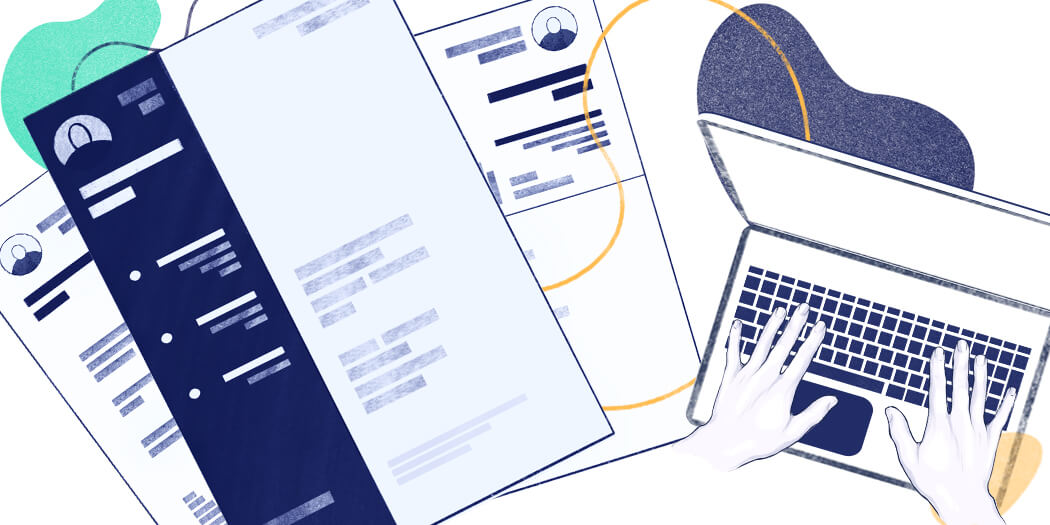
Free Cover Letter Templates for Word to Start With
Unlock your dream job with free, editable Word cover letter templates! Discover a collection of expertly designed templates with pro tips. Download now for a winning application!

Mariusz Wawrzyniak
Career Expert
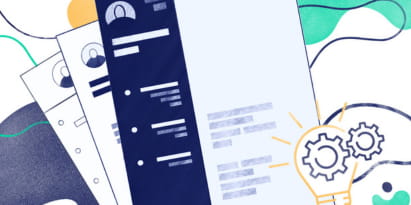
How to Write a Motivation Letter: Sample & Guide for 2024
Did you lose another recruitment process? This can drain your motivation. Maybe what you need is to motivate the recruiter. Do so with a splendid motivation letter!
What’s the Difference Between a Motivation Letter and a Cover Letter

If you’re thinking about applying to college or a new job and want to quickly show how motivated you are, you might looking for the best way to get that done.
Don’t worry, that’s normal, but you need a solution.
After all, when planning to apply for something, it’s essential to make a great first impression .
That’s why many applicants send in a cover letter or a motivation letter .
However, you might be wondering if there’s any difference at all between a motivation and a cover letter, and which one is better for the job you want to land ?
In this article, we’ll explain:
- Cover letter and motivation letter differences
- Benefits of each type of letter
- When to use one letter or the other
Once you understand which is best to include with your application, use our AI-powered resume builder to easily win over employers.
Keep reading to find out the best way to show off your career goals to employers.
Motivation vs. Cover Letter: Key Differences
Employers want to find and hire applicants who are highly motivated as it leads to a number of benefits for the company such as guaranteeing a great company culture and keeping the employee long term.
However, choosing between a cover letter or writing a motivation letter will depend on the type of program or company .
That’s because each letter focuses on different aspects of your qualifications and experience.
Take a look at the differences between the 2 types of letters :
Motivation Letter
- Centers on personal goals and passion for the field and is more personal and reflective, while discussing long-term aspirations.
Cover Letter
- Highlights professional skills and job suitability and is used for professional positions as it showcases relevant achievements and qualifications.
By picking the letter that best fits the position you want , you’ll guarantee that the hiring manager notices your best qualifications and goals.
Cover Letter vs. Motivation Letter: When to Use Them
There are a number of unique motivation letter and cover letter differences and strengths.
This means it’s critical to understand when to use those strengths , or you’ll end up explaining information that isn’t important.
For example, when applying for college or graduate school programs , you should use a motivation letter as it will help you show your passion for your field of study.
Here are other examples of when to use a motivational letter:
- Scholarship applications . Share how the scholarship will help you achieve your educational and career goals.
- Internships : Explain how you want to learn from experienced employees, especially in fields where your academic knowledge is essential.
- Volunteer positions : Mention your commitment and reasons for volunteering to an NGO or other organization that you would like to work with.
When to Write a Cover Letter
Cover letters focus more on your professional qualifications , so they should be used when sending your application to a company or business.
Here are some specific examples:
- When applying to a job : Use your cover letter to connect your experience and skills to the job’s requirements.
- Changing careers : Explain how your existing skills can transfer to the new role in your cover letter.
Even if it’s optional to send in a cover letter with your application, you should do so anyway.
It’s been proven that cover letters help candidates when applying for a position.
Between 2017 and 2021, there has been an 18% growth in the importance of including a cover letter with an application.
Cover Letter and Motivation Letter Differences in Format
Both cover letters and motivation letters differ a bit when it comes to their format. One is a bit longer, while the other is a bit more formal.
However, each letter will have an intro, body, and conclusion .
Cover letter format
If you’re writing a cover letter, you’ll want to keep it to 1 page and keep the vocabulary formal.
Your cover letter should cover the following in the different sections:
- Introduction : Briefly mention your current role or recent job and the position you’re applying for.
- Body : Mention your skills and achievements relevant to the job. Use examples to demonstrate your achievements and how they apply to the new role.
- Conclusion : Restate your interest in the position and invite the employer to review your resume or contact you for further discussion.
Here’s an example of a well written cover letter that mentions a candidate’s skills, accomplishments and more , so that you can better understand the format and style:
Dear [Employer’s Name],
I am writing to express my interest in the Accountant position listed on [Where You Found the Job Posting]. With a strong background in accounting principles and a commitment to accuracy and detail, I am excited about the opportunity to contribute to [Company Name].
In my current role at [Your Current Company], I have successfully managed a diverse range of accounting tasks, including ledger operations, financial reporting, and budgeting.
I am particularly proud of leading a project that streamlined our budgeting process, resulting in a 20% reduction in processing time.
I am eager to bring my expertise in financial management and my proactive approach to problem-solving to your team.
Thank you for considering my application. I look forward to the opportunity to discuss how my skills and experience align with the needs of your team. I am available at your convenience for an interview and can be reached at [Your Phone Number] or [Your Email].
[Your Name]
Motivation Letter Format
A motivation letter on the other hand can be a bit longer and more related to personal goals rather than professional ones.
Here’s what the different sections should go over:
- Introduction : Start with a personal statement or story that reflects your passion for the field or program.
- Body : Discuss your personal journey, long-term goals, and why the program or opportunity excites you. Include relevant personal achievements as well.
- Conclusion : Summarize your ambitions and how the opportunity aligns with your goals, expressing your desire to contribute and learn.
Here’s how your motivation letter can be formatted to show you are the best candidate for an internship position .
Dear [Recipient’s Name],
I am writing to express my enthusiasm for the [Specific Internship Position] at [Company/Organization Name]. My academic background in [Your Major/Field of Study] and my active involvement in [relevant clubs or activities] have fueled my interest in [specific aspect of the field or industry], making this internship an ideal opportunity for my professional growth.
During my studies at [Your University/College], I have developed [mention specific skills or knowledge relevant to the internship], which I am eager to apply in a practical setting
I am particularly attracted to this internship at [Company/Organization Name] because of your commitment to [mention something notable about the company or its values]. The chance to learn from and contribute to your team, especially in [mention a specific area or project of the company], is an exciting prospect for me.
Thank you for considering my application. I am looking forward to the opportunity to discuss how my background and enthusiasm make me a great fit for this internship.
When you write a cover letter or motivation letter, you’ll need to ensure your relevant qualifications and long-term goals shine .
You can do that if you remember the following:
- Motivation letters should be written for internships, organizations, and academic programs.
- Cover letters are more professional and should accompany a job application.
- Motivation letters are a bit more personal.
By using our handy cover letter builder , you can easily create a letter that will prove you are motivated and ready to take on your next challenge.

Trouble getting your Cover Letter started?
Beat the blank page with expert help.
Related blogs
Cover Letter Keywords That Can Make Your Document a Success Take your introduction to the employer to the next level with the most important cover letter keywords and phrases needed to create a successful impression. Updated on August 7, 2023 Cover Letter Keywords That Can Make Your Document a Success
How long should a Cover Letter be? The length of your cover letter is important. You want to show that you’re keen but you also need to keep it short and concise. Find out how to make it perfect! Reviewed Updated on August 9, 2023 How long should a Cover Letter be?
What Not to Put in a Cover Letter? Avoid common cover letter mistakes and start your job application correctly. Grab the hiring manager’s attention and land your dream job. Updated on August 7, 2023 What Not to Put in a Cover Letter?
- Resume Writing
- Resume Examples
- Cover Letter
- Remote Work
- Famous Resumes
- Try Kickresume
Motivation Letter vs Cover Letter: What Are the Key Differences? (+Examples)
- Klara Cervenanska ,
- Updated May 10, 2023 4 min read
If you've ever found yourself scratching your head and wondering about the difference between a motivation letter vs. cover letter, you're not alone.
These two documents, while similar, have distinct uses and contexts that set them apart.
In a nutshell, the main difference between cover letter and a motivational letter lies in the fact that a cover letter is typically used in career settings , while a motivation letter is more common in academic settings .
In this article, we'll dive into the specifics of each document and provide examples to help guide you on when to use which.
Table of Contents
Click on a section to skip
Motivation letter vs. cover letter
What is a cover letter, how to write a cover letter, cover letter example, what is a motivation letter, how to write a motivation letter, motivation letter example, motivation letter vs. cover letter our final piece of advice.
What's the difference between a cover letter and a motivation letter?
Let's sum it up:
Now, let's have a closer look at each of these documents, together with an example of both a cover letter and a motivation letter.
Need a cover letter but hate writing it?
Discover Kickresume's AI Writer and instantly generate ready-to-use cover letters.
A cover letter is a document that serves as your introduction to a potential employer, showcasing your background and explaining why you would be a good fit for the position they're offering.
It should accompany your resume and should complement the information in it.
In essence, it's your chance to present yourself, let your personality shine through, and provide additional details that might not fit within the limited space of your resume.
Even if you lack previous experience in the field, a well-crafted cover letter can help you stand out by highlighting your enthusiasm and positive qualities.
When it comes to writing a cover letter, the structure is just as important as the content. Here's a simple breakdown of the key components to include:
- Opening paragraph : Start with a brief introduction, saying who you are and the position you're applying for. This is your opportunity to grab the reader's attention and encourage them to read on.
- Body paragraphs: Use this section to showcase your relevant skills, experiences, and achievements. Be sure to provide concrete examples and explain how they directly relate to the job you're applying for. This is your chance to demonstrate why you're the ideal candidate for the position and how your background aligns with the company's needs and values.
- Closing paragraphs : In your closing paragraphs, restate your interest in the position and summarize your qualifications. This is also an excellent opportunity to express your enthusiasm and eagerness to contribute to the company's success. Don't forget to thank the reader for considering your application and provide any necessary contact information.
Now that you have a better understanding of what a cover letter entails and how to write one, let's take a look at an example to help illustrate the key concepts.
Marketing and Brand Manager Cover Letter Sample
This cover letter sample was provided by a real person who got hired with Kickresume’s help.
While cover letters are designed for job applications, motivation letters serve a different purpose.
Motivation letter is typically used when applying for academic opportunities such as scholarships, internships, or postgraduate programs, but also when applying for a non-profit organization or voluntary work.
A motivation letter aims to convey your passion for the subject, your personal goals , and how the program or opportunity aligns with those aspirations.
It's an opportunity to showcase your drive, commitment, and enthusiasm for the field, setting you apart from other applicants.
When crafting a motivation letter, it's essential to convey your genuine interest in the program or opportunity and provide a clear explanation of your motivations.
Here's a simple outline to follow:
- Opening paragraph: Begin with an introduction, stating who you are and expressing your interest in the program or opportunity. This is the perfect chance to capture the reader's curiosity and set the tone for the rest of the letter.
- Body paragraphs: In this section, delve into your motivation for pursuing this opportunity, your long-term goals, and how the program aligns with those objectives. Be specific and provide examples, such as relevant experiences or accomplishments, that demonstrate your commitment to the field.
- Closing paragraphs: Wrap up your motivation letter by reiterating your interest in the program or opportunity and expressing your enthusiasm for the potential it offers. Thank the reader for considering your application and provide your contact information.
Now that we've covered the purpose and structure of a motivation letter, let's take a look at an example to help bring these concepts to life.
This sample motivation letter will demonstrate how to effectively introduce yourself, share your motivations and goals, and express your enthusiasm for the academic opportunity:
University Motivation Letter Example
Throughout this article, we've explored the key differences between motivation letters and cover letters.
In a nutshell, a cover letter focuses on your qualifications and suitability for a specific job, while a motivation letter expresses your enthusiasm and reasons for pursuing a particular opportunity, often in educational or volunteering contexts.
Furthermore:
- Cover letter typically includes your contact information, addresses the hiring manager, and is tailored to a specific job posting or company.
- Motivation letter is more general, often used for educational or volunteer programs, and emphasizes your passion, personal goals, and reasons for choosing the opportunity.
By understanding these distinctions, you can confidently craft the right document for your specific needs, be it an academic opportunity or a job application.
Klara graduated from the University of St Andrews in Scotland. After having written resumes for many of her fellow students, she began writing full-time for Kickresume. Klara is our go-to person for all things related to student or 'no experience resumes'. At the same time, she has written some of the most popular resume advice articles on this blog. Her pieces were featured in multiple CNBC articles. When she's not writing, you'll probably find her chasing dogs or people-watching while sipping on a cup of coffee.
Related Posts
Cover letter for phd application: guide for writing one & example from a real phd student, 13 terrible cover letter phrases and how you can fix them, share this article, join our newsletter.
Every month, we’ll send you resume advice, job search tips, career hacks and more in pithy, bite-sized chunks. Sounds good?
You control your data
We and our partners use cookies to provide you with our services and, depending on your settings, gather analytics and marketing data. Find more information on our Cookie Policy . Tap "Settings” to set preferences. To accept all cookies, click “Accept”.
Cookie settings
Click on the types of cookies below to learn more about them and customize your experience on our Site. You may freely give, refuse or withdraw your consent. Keep in mind that disabling cookies may affect your experience on the Site. For more information, please visit our Cookies Policy and Privacy Policy .
Choose type of cookies to accept
These cookies allow us to analyze our performance to offer you a better experience of creating resumes and cover letters. Analytics related cookies used on our Site are not used by Us for the purpose of identifying who you are or to send you targeted advertising. For example, we may use cookies/tracking technologies for analytics related purposes to determine the number of visitors to our Site, identify how visitors move around the Site and, in particular, which pages they visit. This allows us to improve our Site and our services.
These cookies give you access to a customized experience of our products. Personalization cookies are also used to deliver content, including ads, relevant to your interests on our Site and third-party sites based on how you interact with our advertisements or content as well as track the content you access (including video viewing). We may also collect password information from you when you log in, as well as computer and/or connection information. During some visits, we may use software tools to measure and collect session information, including page response times, download errors, time spent on certain pages and page interaction information.
These cookies are placed by third-party companies to deliver targeted content based on relevant topics that are of interest to you. And allow you to better interact with social media platforms such as Facebook.
These cookies are essential for the Site's performance and for you to be able to use its features. For example, essential cookies include: cookies dropped to provide the service, maintain your account, provide builder access, payment pages, create IDs for your documents and store your consents.
To see a detailed list of cookies, click here .
This site uses cookies to ensure you get the best experience on our website. To learn more visit our Privacy Policy
- Cover Letter
Letter of Intent vs Cover Letter: What’s the Difference?

Our customers have been hired by:
Letters of intent, cover letters, covering letters. It’s enough to make your head spin! And let’s face it, you really want to work at that company so you want your application documents to really rock.
So what’s the difference between a letter of intent vs a cover letter?
Con calma. This quick guide will tell exactly what to expect from a letter of intent and a cover letter.
Buckle up and let’s get started.
Want to write your cover letter fast? Use our cover letter builder. Choose from 20+ professional cover letter templates that match your resume. See actionable examples and get expert tips along the way.
Create your cover letter now
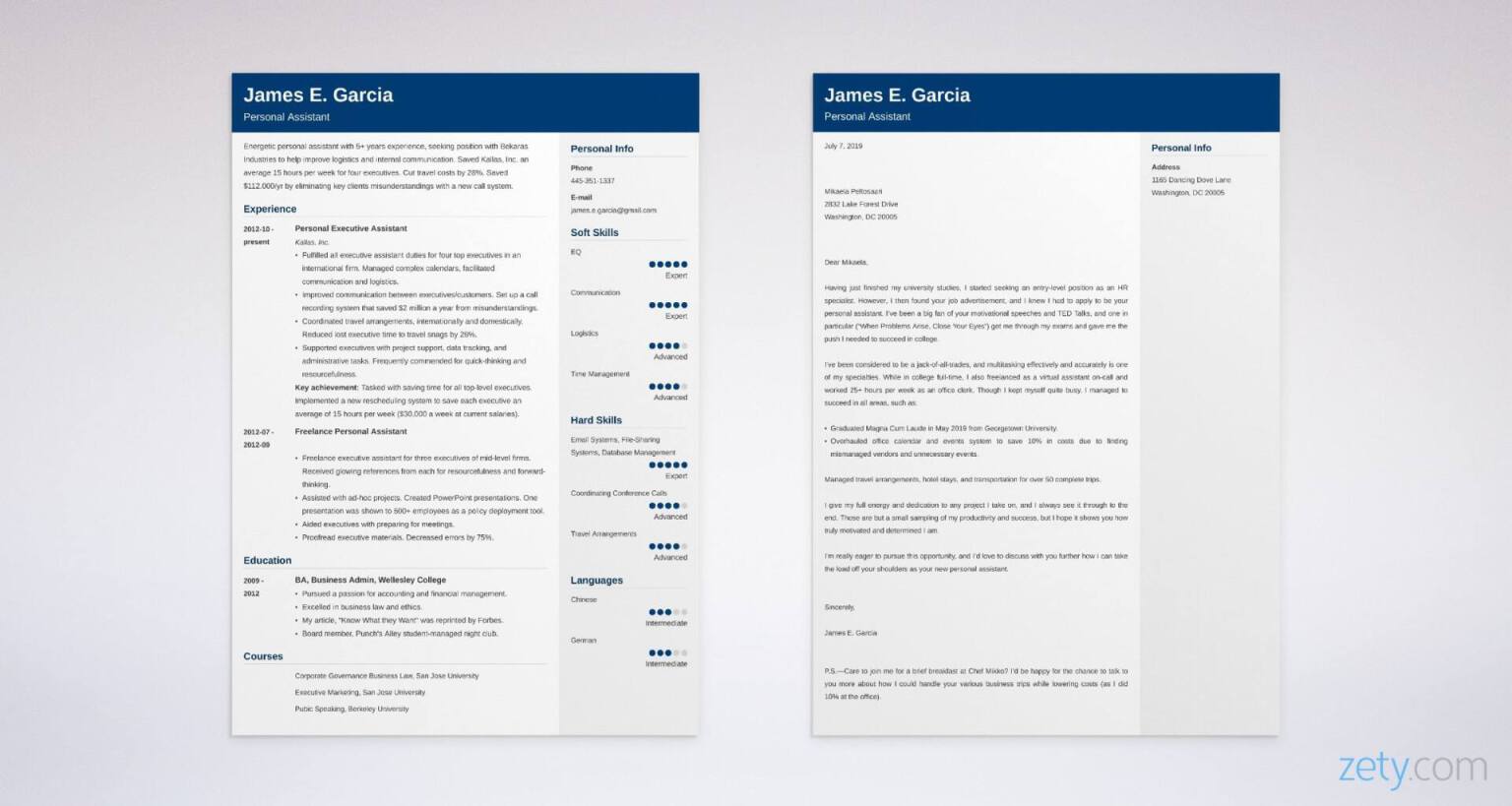
Sample cover letter for a resume— See more cover letter samples and create your cover letter here .
Check out these other guides we have about cover letters and differences:
What is a Cover Letter?
- What is a CV?
- What is a Resume?
- What is a Cold Call Cover Letter?
- Difference Between a Cover Letter and a CV
- Difference Between a Cover Letter and a Resume
- Difference Between a CV and a Resume
- How to Spell Resume?
- How to Write a Pain Letter?
- What is a Motivation Letter?
- Cover Letter Examples for Any Job
Letter of Intent vs. Cover Letter: Letter of Intent Example
Aiden Turner
Network Engineer
1234 Canal Street
New Orleans, Louisiana, 70130
123-456-7890
linkedin.com/in/aiden.turner
New Orleans, March 30, 2022
Eric Kennedy
5678 Industrial Parkway
San Francisco, CA, 94107
Dear Mr. Kennedy,
I am writing to express my interest in the Network Engineer position at Aero Labs, as advertised. With my extensive experience in network engineering and a proven track record at Snap Solutions, I am an excellent candidate for this role.
During my tenure at Snap Solutions, I successfully implemented a network infrastructure overhaul that improved system performance by 35%. This project required meticulous planning, collaboration, and problem-solving skills — attributes I believe would translate well to the role at Aero Labs.
My motivation to join Aero Labs lies in your company's innovative reputation and commitment to building robust, state-of-the-art network systems. With my background in designing and maintaining high-efficiency networks, I am confident I can contribute significantly to your team.
My experience and passion for network engineering make me confident that I can contribute positively to Aero Labs. I am eager to leverage my skills and experience to benefit your company, and I believe it would be in Aero Labs' best interest to have me on board.
I would appreciate meeting with you to discuss how my background and skills would benefit Aero Labs. Please feel free to contact me at your earliest convenience.
Thank you for considering my application. I look forward to contributing to Aero Labs.
What is a Letter of Intent
A letter of intent , known also as a letter of interest, is a letter sent to an employer that expresses your intent to become a part of the company or organization even if there is no open position at that moment.
A letter of intent doesn’t look very different from a cover letter at first sight. But unless asked for by the employer, a letter of intent can stand alone and doesn’t need to be accompanied by a resume or CV.
Letters of intent also stretch outside recruitment and are used in any kind of situation where someone wants to express a certain intent.
Read more: What is a Letter of Intent
A cover letter is written to accompany your resume in the job application you send for a currently open position. Its purpose is to expand on what’s included in your resume by giving you the opportunity to add some examples or stories that prove your experience and job skills .
A good cover letter doesn’t just rehash the information in the resume, but expands on it with examples of your achievements and also by using the job ad as a cheat sheet of what the employer is looking for.
Read more: How to Write a Cover Letter
When making a resume in our builder, drag & drop bullet points, skills, and auto-fill the boring stuff. Spell check? Check . Start building a professional resume template here for free .

When you’re done, our professional resume builder will score your resume and our resume checker will tell you exactly how to make it better.
What’s the Difference Between a Letter of Intent and a Cover Letter?
Though they may look almost identical at first glance, a letter of intent and a cover letter aren’t written in the exact same way.
Let’s break down their differences:
What’s Included in a Letter of Intent
To write a professional letter of intent, you should add the below sections:
- Contact details: include them at the top of the letter.
- Salutation: use “Dear John Smith,” instead of “ To Whom It May Concern ,”
- First paragraph: introduce yourself and why you’re writing to the company. You can mention a specific role you have in mind, but focus mostly on expressing plenty of interest in the company itself.
- Second paragraph: mention your greatest accomplishments and skills with a couple of good examples.
- Third paragraph: explain why you’re interested in joining the company and how you’d think you’d be a great fit. Add a call to action to request an informational interview and discuss opportunities for you in the company.
- Professional closing.
Seems familiar, right?
You’re right. But dive a little deeper and see how a cover letter would be different.
What’s Included in a Cover Letter
To make sure your cover letter is turning heads, follow these tips:
- Add your up to date contact details as well as the employer’s in your cover letter heading .
- Include a professional cover letter salutation , preferably using the hiring manager’s name .
- Start your cover letter with an intriguing opening paragraph that introduces you and the role you’re applying for.
- Demonstrate your value by using examples and achievements that show you have the experience and skills the company is looking for.
- Mention your interest in the company and how you believe you’d be the perfect fit to the team. Add a call to action and ask for a call or meeting to discuss your experience further.
- End your cover letter with a professional cover letter closing.
- If necessary, add a cover letter enclosure .
See how the cover letter is much more tailored to the open position and detailed? A letter of intent, on the other hand, focuses more on the company or on the school, i.e., letter of intent for a medical school . You can mention something you know about them (for example their product) and show you’re keeping up with the industry.
Cover letters and letters of intent also aren’t sent in the same ways. Letters of intent can be sent at any moment while cover letters are sent only when you are applying for a specific position.
If you’re applying for a job opening like most people usually do, definitely write a cover letter that will go along with your resume. If, however, you’d really love to work for a certain company, but they don’t seem to be hiring at the moment, or if a job ad asks for it specifically, a letter of intent is the way to go.
Thanks for reading! Have you noticed any differences between a letter of intent vs a cover letter that weren’t touched on? Let us know in the comments!
About Zety’s Editorial Process
This article has been reviewed by our editorial team to make sure it follows Zety's editorial guidelines . We’re committed to sharing our expertise and giving you trustworthy career advice tailored to your needs. High-quality content is what brings over 40 million readers to our site every year. But we don't stop there. Our team conducts original research to understand the job market better, and we pride ourselves on being quoted by top universities and prime media outlets from around the world.

Don't miss out on exclusive stories that will supercharge your career!
Get a weekly dose of inspiration delivered to your inbox
Similar articles

15+ Clean Minimalist Resume Templates (Sleek Design)
Those 400+ minimalist resume templates above? Meh. Who’d have the time to scroll through all of them? Well. We did. So you don’t have to. Here are the best of the best.
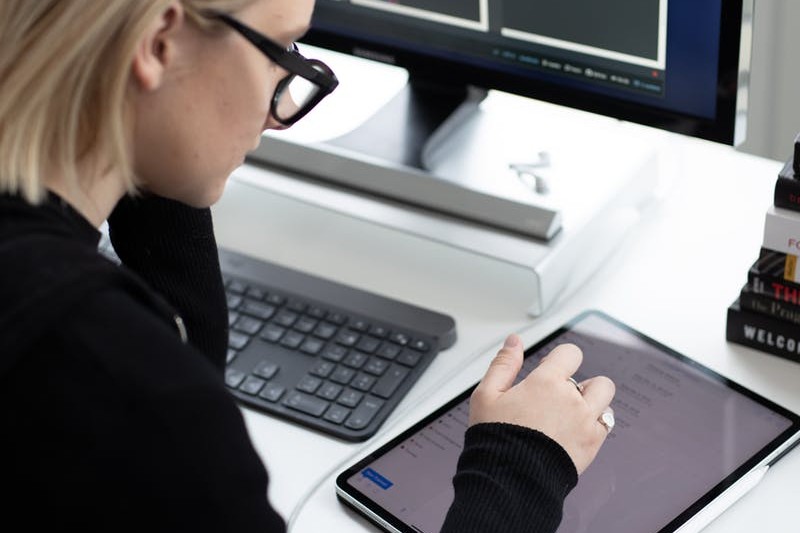
15 Basic & Simple Cover Letter Templates
Your cover letter doesn’t need glitz to catch the eye. We’ll show you 15+basic/simple cover letter templates that will definitely have the recruiter look twice.

Eye-Catching Resume Templates: How to Get Noticed in 2024
Sick of recruiters turning a blind eye to your resume? Learn how to write an eye-catching resume that will get noticed.
All Formats
Difference Between Job Application Letter and Cover Letter
Have you ever tried writing business letters ? If so, what type of business letters have you tried writing? In terms of writing such letters, you may have mistaken one for another, such as believing that a job application letter and a cover letter are the same. An application letter and a cover letter are two completely different things. A job application letter template is a letter that contains your intentions about the job, while a cover letter introduces the applicant and is usually submitted together with a resume. Cover letters in Word and job application letter writing follow almost the same guidelines but differ on how they should be presented. However, whether it’s for college admission or business employment, both letters are integral to the application process. Use these short yet formal letters when answering a job vacancy for a hotel manager, construction engineer, retail clerk, marketing teacher, company accountant, and more. From fresh graduate applicants to seasoned professionals, the right letter is vital for any jobhunter.
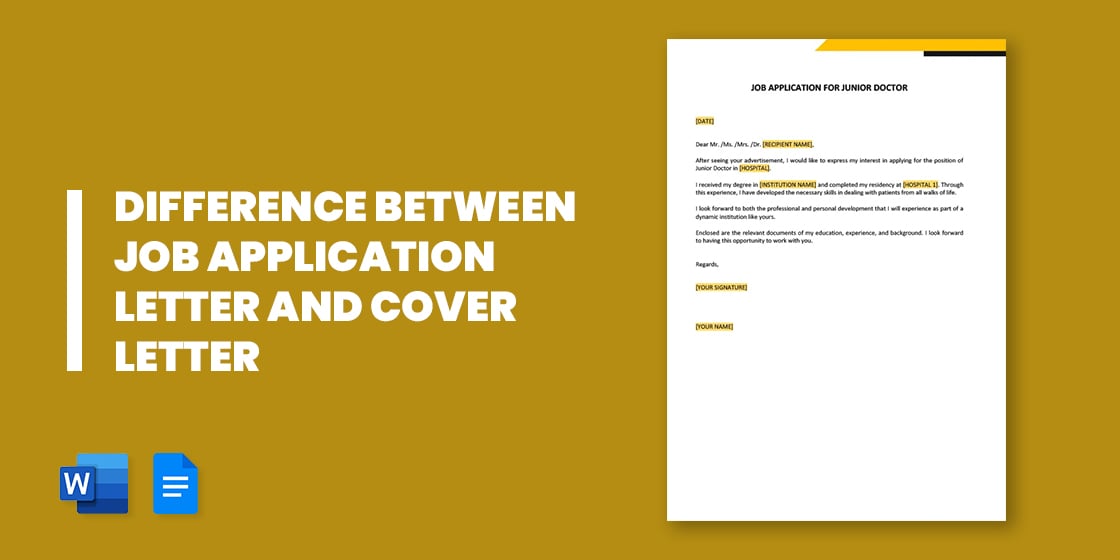
Difference Of Application Letter and Cover Letter
Application letter.
- A job application letter format in Word is a business letter that states an applicant’s intention in a specific job applying for.
- It is a letter that provides detailed information about the applicant.
- It explains how a person was able to discover the job, how interested is he in the job, as well as the reasons why he wanted to be chosen.
- Skills and abilities are also clearly identified in a scholarship application letter because it helps in determining how qualified the applicant is.
Formal Job Application Letter Template
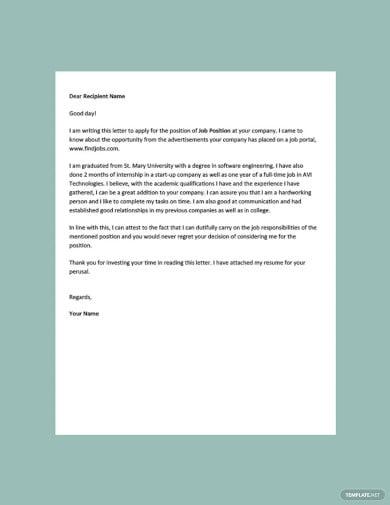
- Google Docs
Job Application Letter for Junior Doctor Template
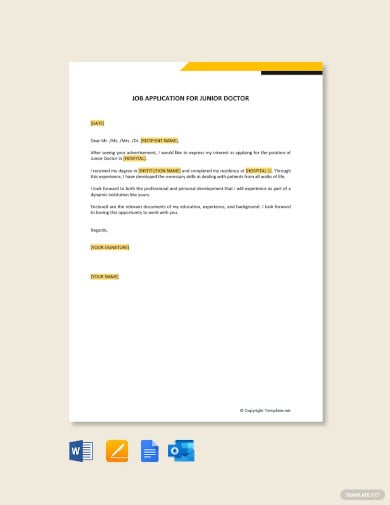
- Apple Pages
Email Job Application Letter Template

Fresher Job Application Letter Template

Job Application Letter for Undergraduate Student Template
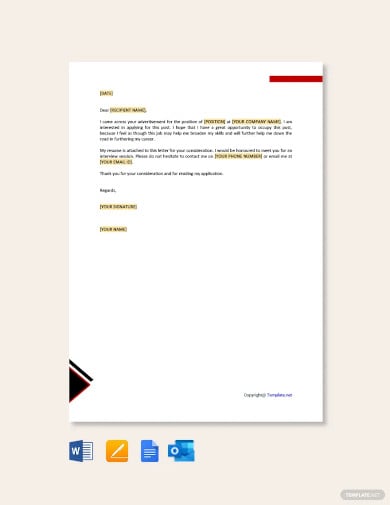
Job Application Letter For Junior Accountant Template
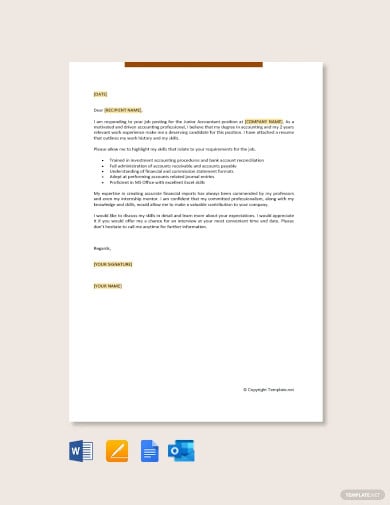
Marketing Assistance Job Application Letter Template
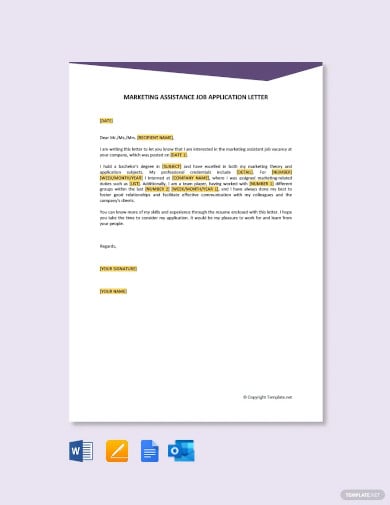
Job Application Letter for Medical Doctor Template
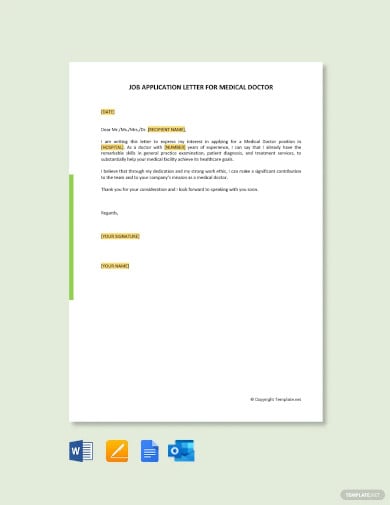
Job Application Letter for Assistant Professor Template
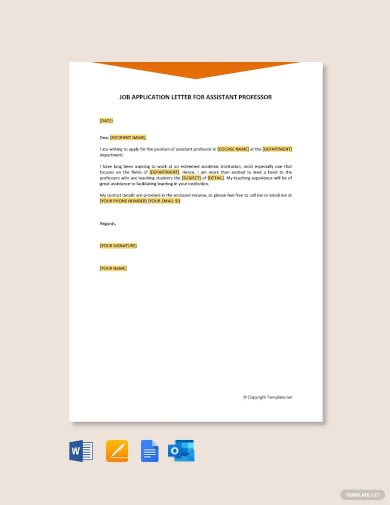
Job Application Letter For Graphic Designer Template
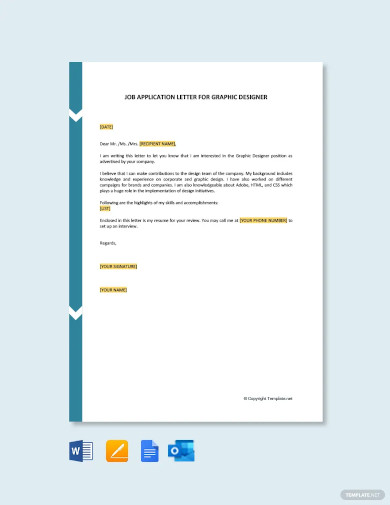
Job Application Letter for Executive Secretary Template
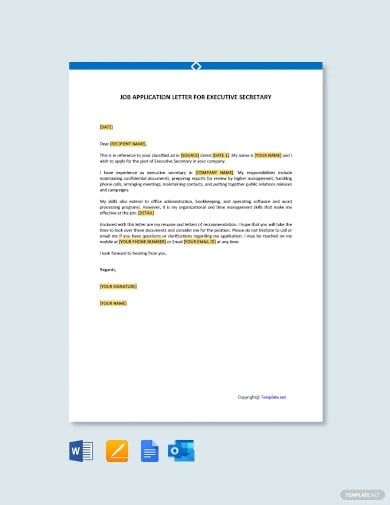
Job Application Letter for Executive Template
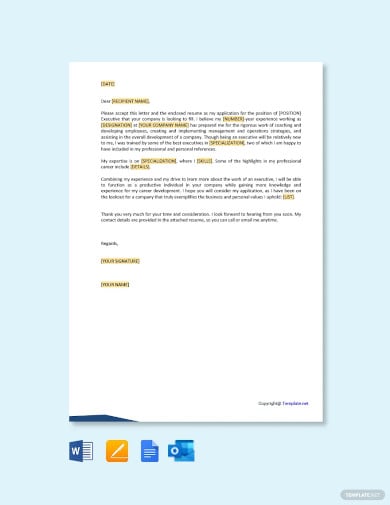
Job Application Letter for Executive Assistant Template
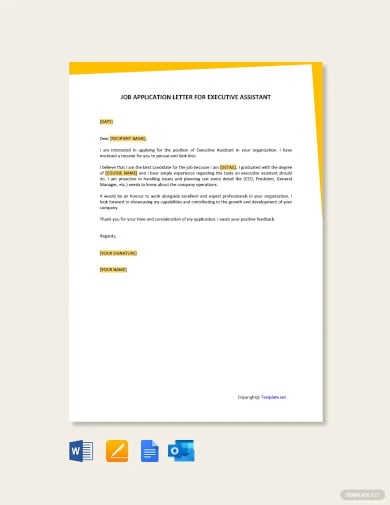
Job Application Letter For Receptionist Position Template
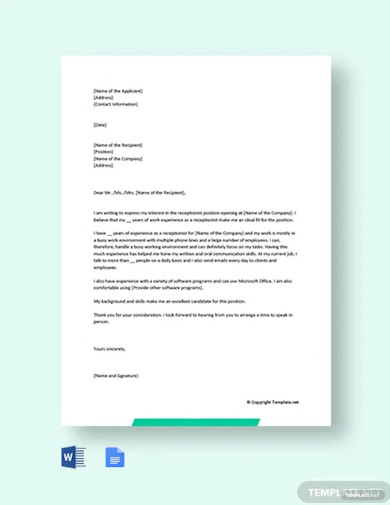
Job Application Letter For Receptionist Template
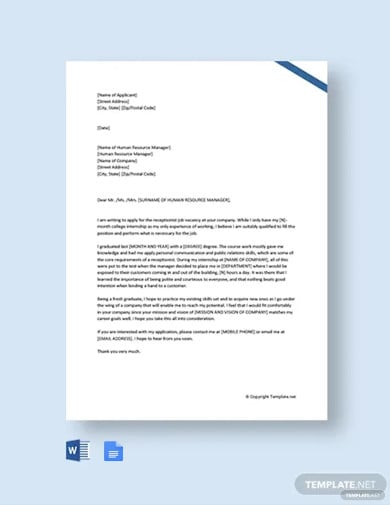
Job Application Letter Template For Accountant
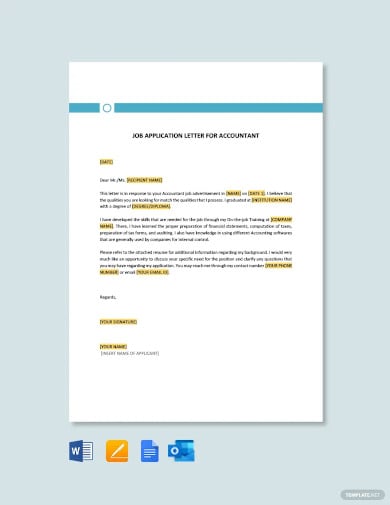
Job Application Letter Template For Assistant
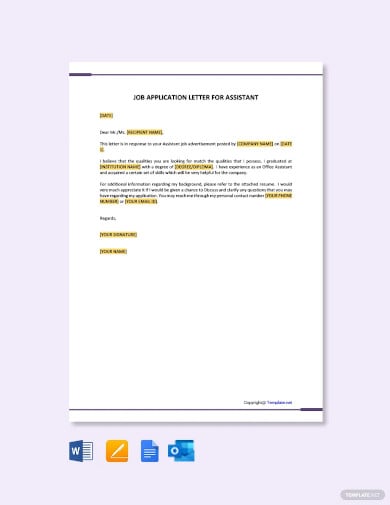
Job Application Letter Template For Software Engineer
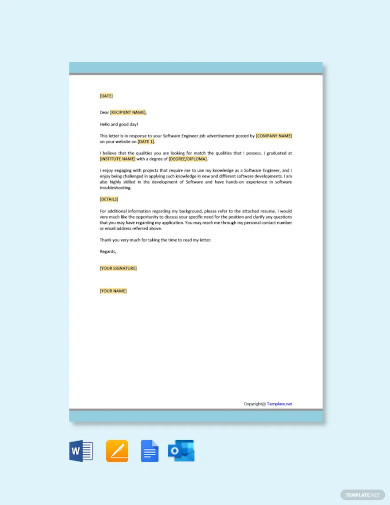
Job Application Letter for Pastry Chef Template

Job Application Letter for Volunteer Template
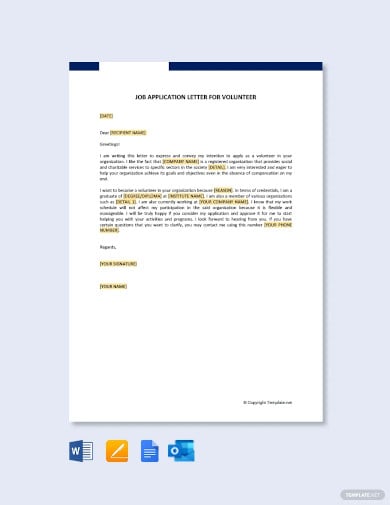
Job Application Letter for Administrative Position Template
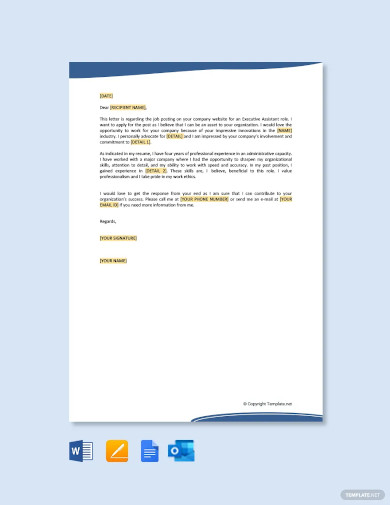
College Admission Application Letter Template
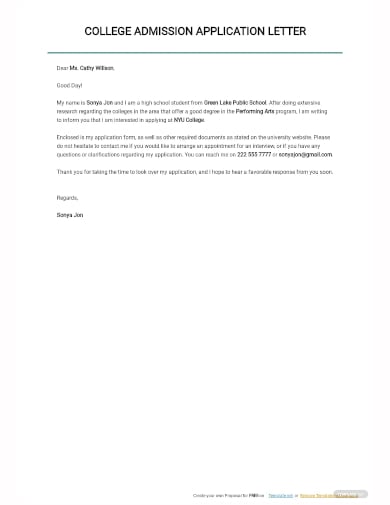
Job Application Letter For Accountant Assistant Template
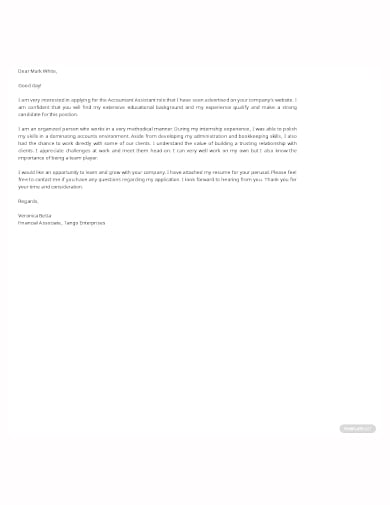
Job Application Letter for Employment Template
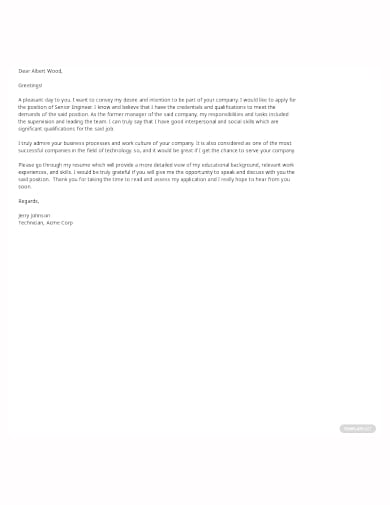
Job Application Letter for Teacher Vacancy
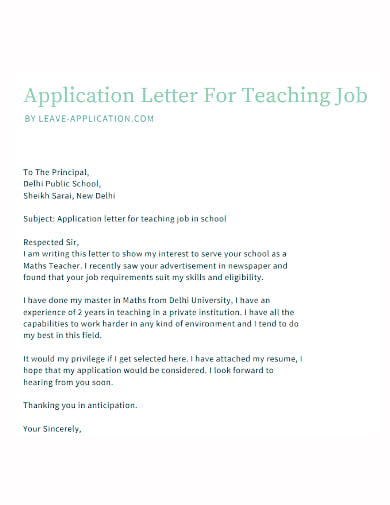
Fresh Graduate Resume Civil Engineer Entry Level
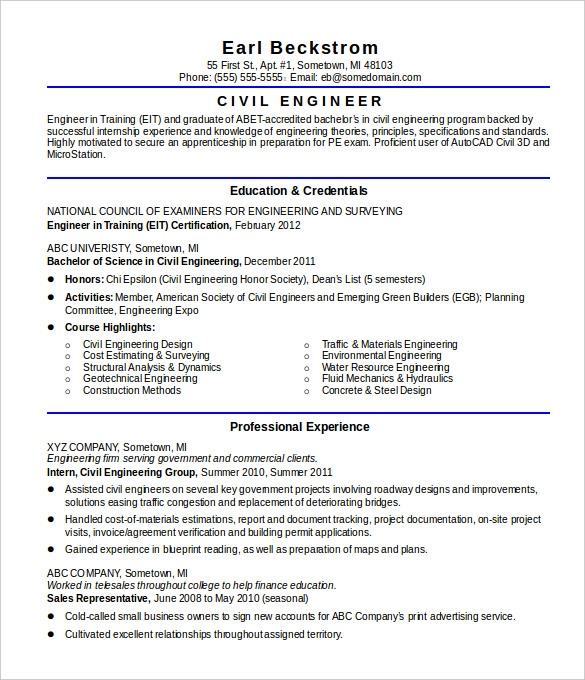
Cover Letter
- A cover letter template in Google Docs , on the other hand, is a letter that introduces an applicant, it mentions the job title a person is applying for.
- The purpose of a cover letter ( cover letter samples in PDF ) is to encourage someone in the recruitment team to read an applicant’s resume.
- A cover letter also matches the skills and abilities required by the job.
- It is a document that does not exceed more than one page.
- The closing of a cover letter is usually in the form of a call to action.
Cover Letter For Teacher Job Application Template
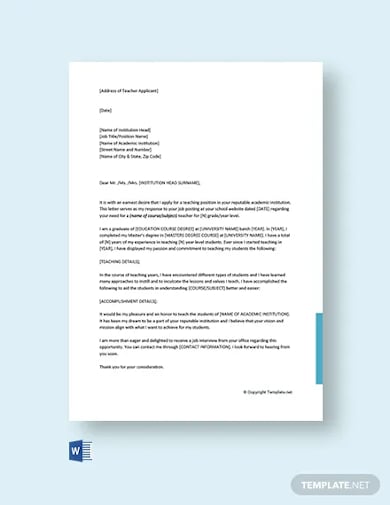
Hotel Marketing Manager Cover Letter Template
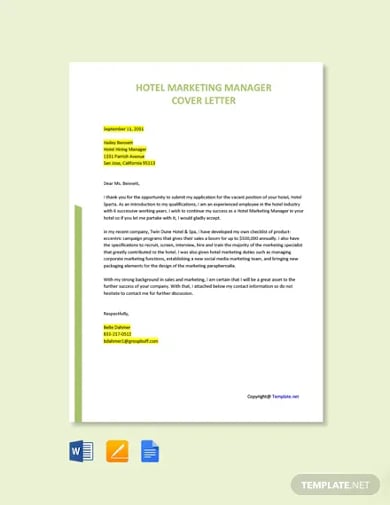
Formal Business Cover Letter Template
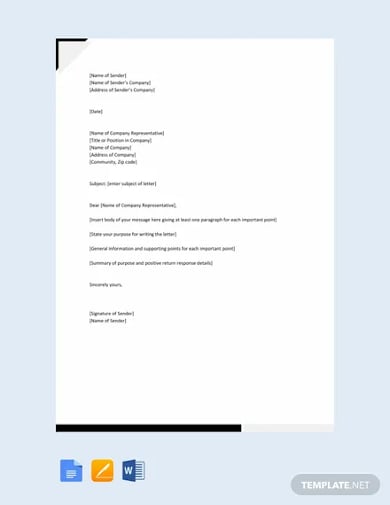
Short Finance Clerk Cover Letter Template
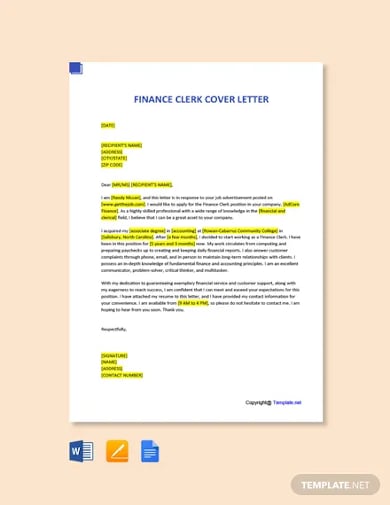
Merits of Application Letter and Cover Letter
- Cover letters and college application letters formally introduce the job applicant. It describes how skills and abilities qualify a person for the job they applied for.
- They also explain unique traits and other significant experiences that molded a person into becoming an ideal employee in the designated area of expertise.
- They also serve as supporting details of a resume and a curriculum vitae. The things in the bullet list of a resume or curriculum vitae can be clearly explained in an application letter and accountant cover letter with emphasis.
- They also help explain the things you wanted to contribute to the company you are applying for.
- Lastly, cover letters and application letters make stand out among other applicants because the two documents can’t get a second look, it is mainly unique because each person is different and has different styles and ways of doing things.
More in Letters
- FREE 26+ Covid-19 Letter Templates in PDF | MS Word | Google Docs
- Thank You Letter for Appreciation – 19+ Free Word, Excel, PDF Format Download!
- 69+ Resignation Letter Templates – Word, PDF, IPages
- 12+ Letter of Introduction Templates – PDF, DOC
- 14+ Nurse Resignation Letter Templates – Word, PDF
- 16+ Sample Adoption Reference Letter Templates
- 10+ Sample Work Reference Letters
- 28+ Invitation Letter Templates
- 19+ Rental Termination Letter Templates – Free Sample, Example Format Download!
- 23+ Retirement Letter Templates – Word, PDF
- 12+ Thank You Letters for Your Service – PDF, DOC
- 12+ Job Appointment Letter Templates – Google DOC, PDF, Apple Pages
- 21+ Professional Resignation Letter Templates – PDF, DOC
- 14+ Training Acknowledgement Letter Templates
- 49+ Job Application Form Templates
File Formats
Word templates, google docs templates, excel templates, powerpoint templates, google sheets templates, google slides templates, pdf templates, publisher templates, psd templates, indesign templates, illustrator templates, pages templates, keynote templates, numbers templates, outlook templates.

IMAGES
VIDEO
COMMENTS
The work experience of an application letter contains more details about previous jobs you've worked, while a cover letter contains brief information about relevant experience. An application letter should contain the name of the company you worked for, including the duration of your employment and information about specific responsibilities.
The work experience section of an application letter contains more details about previous jobs you've worked, while a cover letter contains brief information about relevant experience. An application letter contains the name of the company you worked for, including the duration of your employment and information about specific responsibilities.
However, the major difference between a cover letter and an application letter lies in the content. A cover letter, which is usually submitted along with a resume, focuses on expressing your interest in the position. An application letter meanwhile can replace a resume and a cover letter and briefly describes your education and work history.
2) Job application letter for academic programs. When there is a requirement to describe depth of academic experience, a longer-form letter is sometimes employed in academic circles instead of a resume. Here, the letter of application vs cover letter argument is won in favor of academic rigor.
A cover letter is almost always used to express interest in employment. An application letter can be used for employment purposes; however, it can also be used for applying for a place in an academic program or an internship program. Employers don't always require a cover letter, but it's always a good idea to use a cover letter.
Reviewed By Conrad Benz, Hiring Manager. A cover letter is a one-page document included in your job application (along with your resume ). When written well, your cover letter provides employers with important context that isn't covered in your resume. March 4, 2024. Build My Cover Letter Now.
A cover letter is a letter containing three to four paragraphs that a job seeker or an internship applicant shares with their prospective employer when applying for a job. A cover letter is submitted alongside the applicant's résumé and in many ways complements it. While a résumé lists the applicant's employment and education history ...
Cover letter format. Your cover letter should be one page long and use a simple, professional font, such as Arial or Helvetica, 10 to 12 points in size. Your letter should be left-aligned with single spacing and one-inch margins. Jenn shares her advice on how and why to write a cover letter.
start your cover letter. with your contact details at the top. These should be in your cover letter's header, separated neatly from the bulk of your text. Here, you want to include all the essential contact information, including: Full Name. Your first and last name should stand out at the top. Job Title.
An application letter sent through email requires a subject line that details your purpose for writing— consider " [job title], [your name].". The placement of your contact information is also different depending on the medium. In a hard copy, this goes at the top of your letter, as a header.
Be positive and enthusiastic. Give your cover letter for a job a positive, enthusiastic tone. Use future tense to show how you will use your skills and experience to benefit the company you're applying to and show how keen you are to take on a new role and new challenges. If you are lacking experience in some areas, don't highlight it.
The differences between a resume and cover letter There are three main differences between resumes and cover letters: 1. Format Your cover letter is a professional communication structured in full paragraphs, while your resume should have sections with bullet points that convey specific details like dates of employment and job duties.
Just like with an application letter, proofread and edit your cover letter carefully to ensure it is error-free and well-written. Attention to detail is crucial. When to Use a Cover Letter. Cover letters are typically used when: You are applying for a job without a specific job posting. The job application process requires a cover letter.
There are 3 types of cover letters that you can send to a hiring manager. The 3 types are: Application cover letters. Letters of Interest. Email Cover letters. The letter you write is influenced by whether you are going to apply for a job directly, citing a referral, or asking about vacancies that are not advertised.
A cover letter, on the other hand, is highly recommended but isn't necessarily required unless the job application specifically requests the inclusion of a cover letter. ... Another main difference between a cover letter vs resume is the layout and structure of each. A resume typically uses bullet points without paragraphs or large chunks of text.
Use the same font you chose for your resume. Left-align all content. Keep your application letter length to only one page. Just like with your resume margins, set them to 1-inch on your job application letter as well. Leave ample white space by using double-spacing between paragraphs and setting line spacing to 1.15.
It's been proven that cover letters help candidates when applying for a position. Between 2017 and 2021, there has been an 18% growth in the importance of including a cover letter with an application. Cover Letter and Motivation Letter Differences in Format. Both cover letters and motivation letters differ a bit when it comes to their format.
Choose an appropriate font for your application letter, like Calibri or Helvetica. Set the font size between 10 and 12 pt. Adjust margins to at least 1 inch on all sides. Use 1.0 or 1.15 line spacing and insert an additional line between paragraphs. Align text to the left or use justified alignment.
In a nutshell, the main difference between cover letter and a motivational letter lies in the fact that a cover letter is typically used in career settings, while a motivation letter is more common in academic settings. In this article, we'll dive into the specifics of each document and provide examples to help guide you on when to use which.
Format of an Application Letter. Create enough spacing: 1-1.15 between lines, 1-inch margins, double space between paragraphs. Choose the font: Garamond, Helvetica, or Arial in 11-12 points in a font size. Align the content to the left. Pick the file format: PDF, unless the recruiter requested a Word file specifically.
The difference between a cover letter and a resume. There are four key differences between a cover letter and a resume: 1. Importance. Resumes are a requirement when you apply for work. On the other hand, cover letters are often necessary, but optional when a company specifically says to not include one.
You can mention something you know about them (for example their product) and show you're keeping up with the industry. Cover letters and letters of intent also aren't sent in the same ways. Letters of intent can be sent at any moment while cover letters are sent only when you are applying for a specific position.
Job application: A cover letter is the usual choice when applying for a job, as it emphasises your professional qualifications and demonstrates how you can contribute to a company's success. Academic programme or scholarship application: A motivation letter is typically more appropriate for these situations, as it delves into your passion ...
This is best answered with, "It depends"—for both the cover letter and the accompanying email. (I know, just doing my part to make things simple here.) In all seriousness, it's best to evaluate the tone and style of the organization you're attempting to join, and then guess which salutation would be most would the appropriate and ...
Difference Of Application Letter and Cover Letter. About the application of jobs cover letters, a cover letter and an application letter are the documents an applicant must use.But the two differ in some ways too. If you are searching for application letter templates, perhaps you are on the right site. Application Letter. A job application letter format in Word is a business letter that states ...